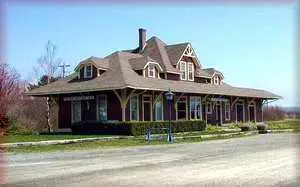 |
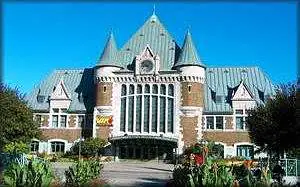 |
|
|
|
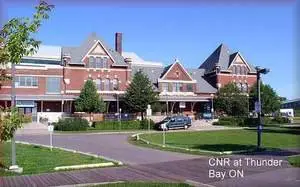 |
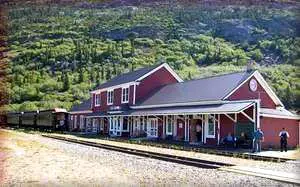 |
|
|
|
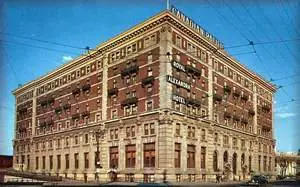 |
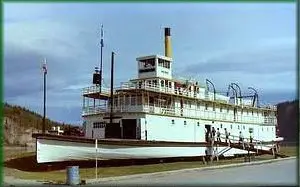 |
|
|
|
Old Canadian Train Stations and
Railway Yards
Western Canada
Alberta
Links to the other areas of Canada
 |
 |
|
|
|
 |
 |
|
|
|
 |
 |
|
|
|
Return
to Old Canadian Train Stations
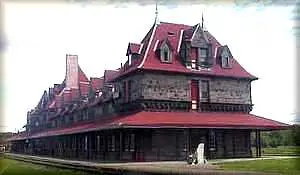
|
|
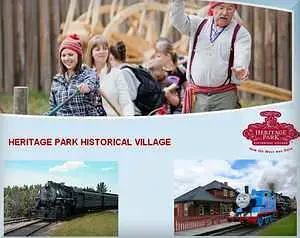 |
|
|
|
|
Shepard Station at Calgary's Heritage park,
1900 Heritage Drive SW. Shepard is still an active CPR point on their Brooks Sub between Medicine Hat and Calgary,(about 10 miles from Calgary's Alyth Yard). The station, built in 1910, was donated to Heritage Park by the CPR when it became vacant and now provides visitors with ticket sales, food services, water fountain and public washrooms. It is also wheelchair accessible. |
| This picture was taken and submitted by Massey F. Jones |
|
|
| A more formal name for the CPR station in Lethbridge at 801 � 1st
Avenue South is �Union Station�, so called because the Canadian Pacific
and the Alberta Railway and Irrigation Company jointly operated the building
from its construction in 1906, up to 1912, when the Alberta Railway and
Irrigation Company was dissolved and CPR took over sole ownership. For
a period of time, the Grand Trunk Pacific Railway also maintained a freight
office in the station.
Starting in 1895, CPR built a 1.5 mile spur from its Medicine Hat-Crownest mainline to serve the small village called Coalbanks and thus, avail themselves of a ready supply of coal from area mines for its locomotives. The Crownest area is situated where Southwestern Alberta, meets southeastern BC, close to the US border. (Coal mining is still ongoing in the area for the Asian markets and transported by long CPR unit trains of gondolas, to the Robert Bank Superport in the Greater Vancouver area; through the Elk Valley towns of Elko, Fernie, Sparwood and others in Southern BC) on the Cranbrook Sub. In 1905, Coalbanks changed its name to Lethbridge. City fathers then encouraged the CPR to relocate its division point from Fort Macleod (further north towards Calgary) to Lethbridge with land and tax incentives. CPR then built their station in 1906, along with a freight shed and roundhouse; following the basic two-storey, Chateau-style railway station design used for their South Edmonton (Strathcona) and Red Deer stations featured on this page. It incorporates a hexagonal tower at the street entrance and dormers along the roof. Between 1907 and 1909, the spectacular CPR High Level Bridge was constructed (along with a smaller version near Monarch, featured on my Bridge page). It wasn�t until 1983 that the Lethbridge station was closed. In 1971, CPR abandoned RDC Dayliner passenger service to Calgary but still used the building as a freight depot for another 12 years. A 1977 study had meanwhile recommended that the CPR relocate its tracks away from the downtown core and move its rail yard. In 1980, CPR tracks were moved about a block north, while most of the railway operations centered at Kipp, Mile 11.0 CPR Crownest Sub., about 5 miles northwest of Lethbridge towards Calgary. Today, what is left of Lethbridge Yard is at Mile 7.9 and serves only local industries. Whatever goes in and out of Lethbridge travels on the iconic CPR High Level Bridge, situated about 5 blocks or so west of the old station. Service in infrequent but some of the heavy haul (freight) goes through Lethbridge into the US. The downtown area formerly occupied by the yard then became the Park Place Shopping Centre. Having lost its connection to the mainline, the old CPR station lost its purpose. So as not to lose a valuable historic asset, it was decided in 1986 to give the Lethbridge Union Station a second life by restoring it as the Lethbridge Community Health Centre. In May 1987, the building was declared a Provincial Historic Resource. To further enhance the city�s railway history, CPR locomotive 3651 (MLW 2-8-0) formerly displayed across the street on the north side of Galt Gardens and subject to frequent vandalism, was moved to the former station platform; where it is displayed today, restored behind a wrought iron fence (see my CPR locomotive page) . In 1988, CPR wooden caboose 437083 built in 1943, was added to the east side of the station to complete the setting. View it on my caboose page. |
.jpg) |
A plaque on the street side of the former Lethbridge
CPR Station honours its history. It was formerly named "Union Station" because the Canadian Pacific
Railway shared the building with the
The plaque mentions that "Since 1987, the building has
The locomotive and caboose are covered in other pages
|
| This picture was taken and submitted by Massey F. Jones | |
.jpg) |
The Lethbridge Station and caboose viewed from the southeast corner
of Stafford Drive and 1st Avenue
South on April 11th, 2014. |
| This picture was taken and submitted by Massey F. Jones | |
.jpg) |
The former Lethbridge CPR station from across the
street, looking northeast. A driveway at the end of the building leads into the Health Unit parking lot. Park Lane Mall behind the station is now occupying a
To the extreme left, the stone monument bearing
|
| This picture was taken and submitted by Massey F. Jones | |
.jpg) |
The sun came out to show us a nice portion of the
former CPR Lethbridge station from across 1st Street North. After being refurbished inside, the building became designated as
a provincial historical site. While it is
|
| This picture was taken and submitted by Massey F. Jones | |
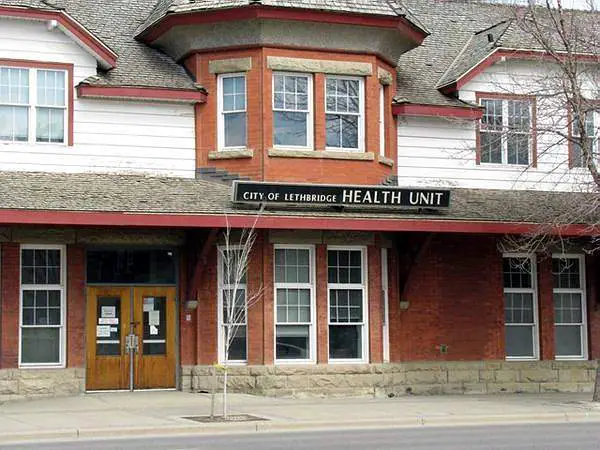 |
The centre portion of the former Lethbridge CPR station.
Notice the iconic octagonal tower, and the row or
|
| This picture was taken and submitted by Massey F. Jones | |
|
|
The end of the former freight shed at the west end of the station.
At the turn of the 20th Century, the freight shed
of Union Station as it was known then; was shared by the Canadian Pacific, the Alberta Railway and Irrigation Company and for a while, the Grand Trunk Pacific Railway. Notice Consolidation locomotive CPR 3651 to the
|
| This picture was taken and submitted by Massey F. Jones | |
|
|
To the left, the main door looking west behind the
station, which led passengers to the platform, to catch the Canadian Pacific Railway �Dayliner� (RDC) to Calgary up to 1971, when service was abandoned. The station continued with freight service until 1980 when the tracks which used to run where the newer portion now stand, were moved about a block north. The door into the new portion leads into the health
|
| This picture was taken and submitted by Massey F. Jones | |
|
station was a beehive of activity |
|
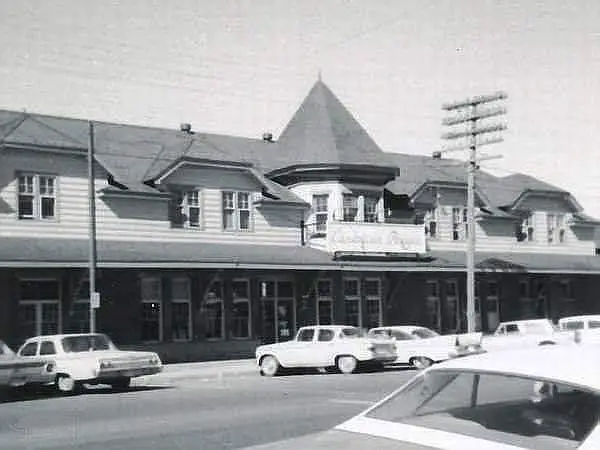 |
Looking east across 1st Avenue South, we now have
a close-up of the Lethbridge Union Station in 1966 when it was in use. More at https://hermis.alberta.ca/ARHP/Details.aspx?DeptID Notice the way that the cars are parked in front of the
CPR wooden caboose 437083 built in 1943, was added
|
| Massey F. Jones collection | |
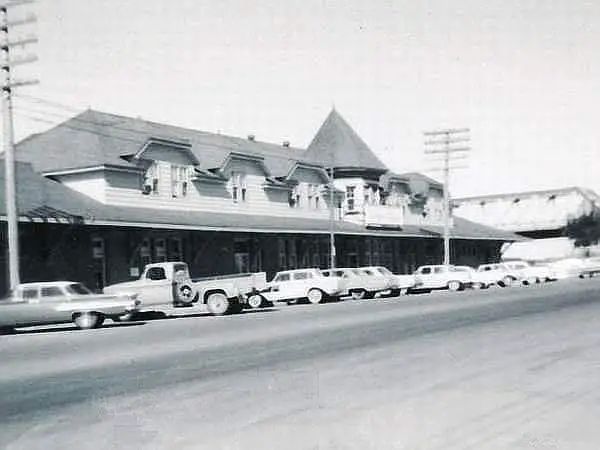 |
A 1966 view looking east, of the Lethbridge, Alberta
CPR station; at 801 1st Avenue South. Built in 1905-1906, the CPR station closed in 1983,
The bridge to the far right is Stafford Drive North,
|
| Massey F. Jones collection | |
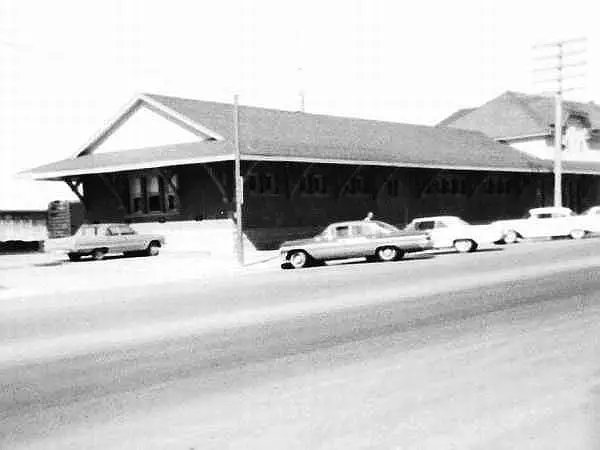 |
The CPR Lethbridge station freight shed, looking
northeast in 1966, with active rolling stock still behind the station. In 1980, an agency was established to relocate the
After the was station was preserved, CPR locomotive
|
| Massey F. Jones collection | |
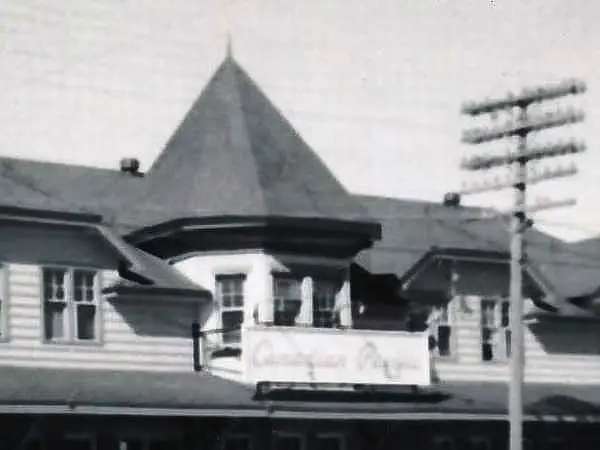 |
Only a very simple white sign under the octagonal tower
in the CPR 'Script Lettering', marked the main entrance to the Lethbridge Canadian Pacific Station this 1966 view. Passenger service was abandoned in 1971 and freight
Early 20th Century views of the Lethbridge
|
| Massey F. Jones collection | |
|
|
Consolidation CPR 3651 (MLW 2-8-0) relocated from
Galt Gardens across the street in 1987 is now displayed to the rear of the former Lethbridge station, almost where the mainline used to run, in this view looking w est on March 11th, 2014. The large building in front of the locomotive is the
|
| This picture was taken and submitted by Massey F. Jones | |
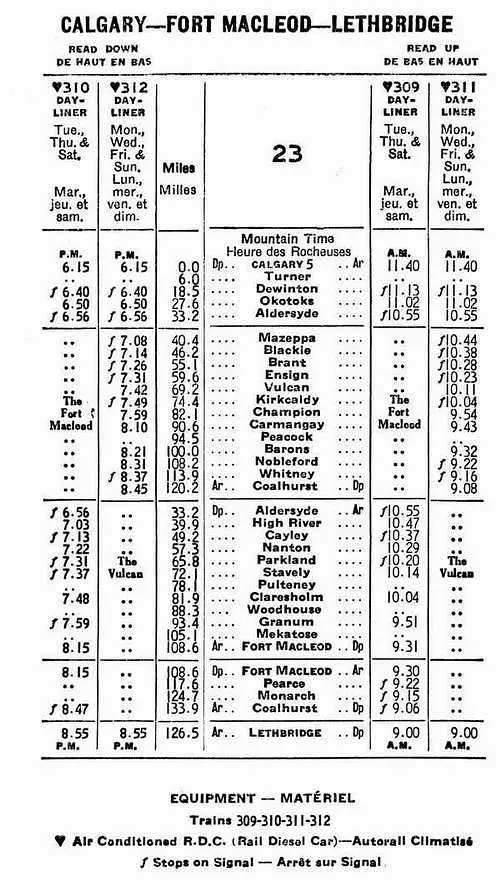 |
The Calgary-Lethbridge passenger service, from
CPR public timetable April 30th, 1967 to October 28th, 1967 (during Expo 67). Out of Calgary for the first 6 miles, the RDC followed the route of the present Calgary Transit south LRT line (yet to be constructed), Passenger service between the two cities was
|
| Massey F. Jones collection | |
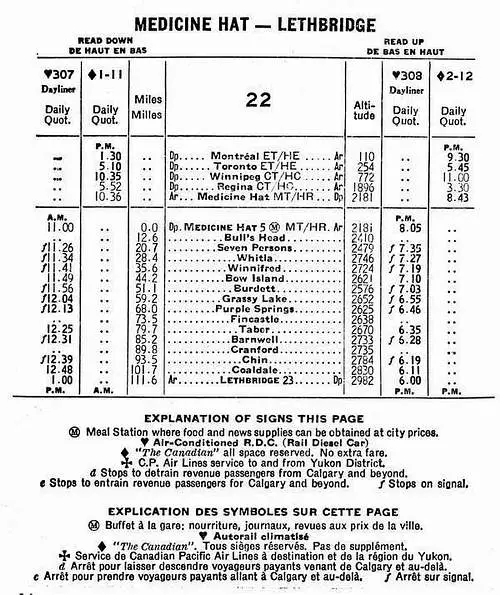 |
Another RDC service to Lethbridge, this one
designed for a fast connection on "The Canadian" to and from Montreal, during Expo 67. As with the Calgary-Lethbridge elsewhere on the
|
| Massey F. Jones collection | |
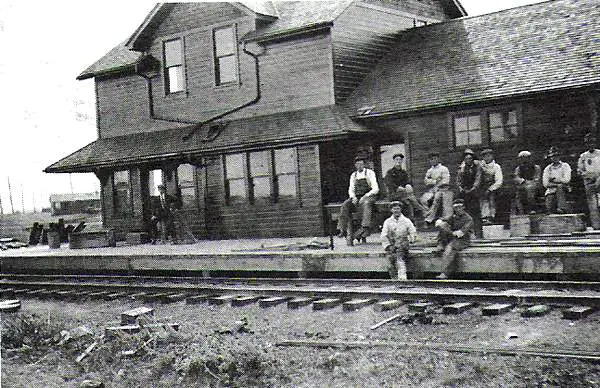 |
Stirling Station Construction Crew 1900
.
|
| These photos are from the Stirling Historical Society and we submitted
by
Cody Kapcsos |
|
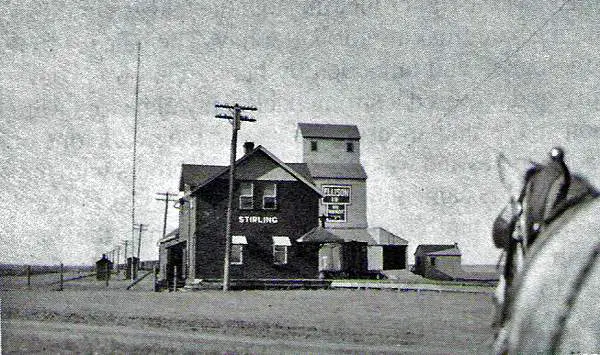 |
The Stirling Station and grain elevators, year unknown |
| These photos are from the Stirling Historical Society and we submitted
by
Cody Kapcsos |
|
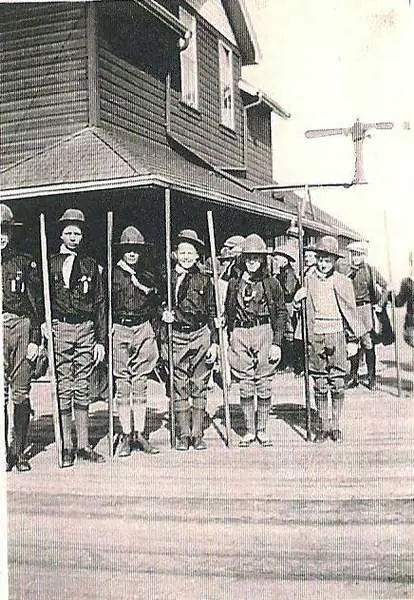 |
Stirling Scouts at Station, Stirling Alta. Date Unknown |
| These photos are from the Stirling Historical Society and we submitted
by
Cody Kapcsos |
|
 |
1920s Flood Maybutt, Alta |
| These photos are from the Stirling Historical Society and we submitted
by
Cody Kapcsos |
|
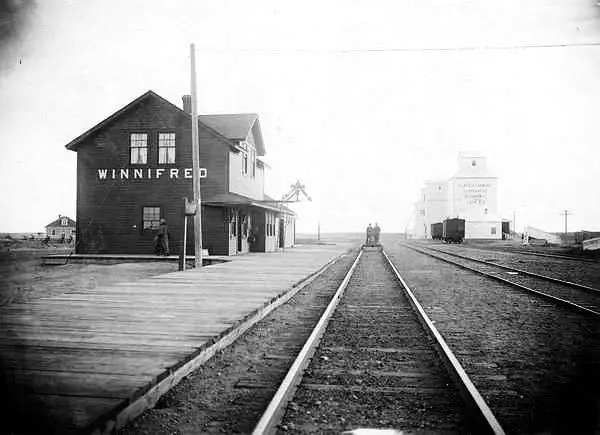 |
Winnifred, Alberta Station. Year unknown |
| This picture was submitted by Cody Kapcsos | |
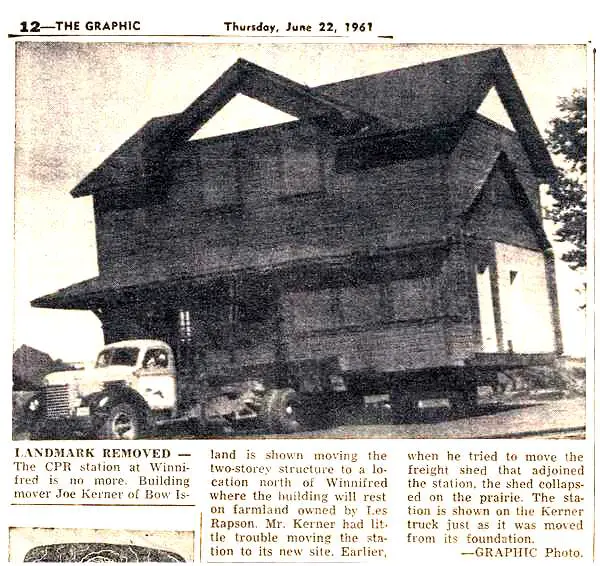 |
Moving the Winnifred, Alberta Station, newspaper clipping
about the move of the station in 1961. The stastion burned in the 1970s because of the deteriorated condition of the building. |
| This picture was submitted by Cody Kapcsos |
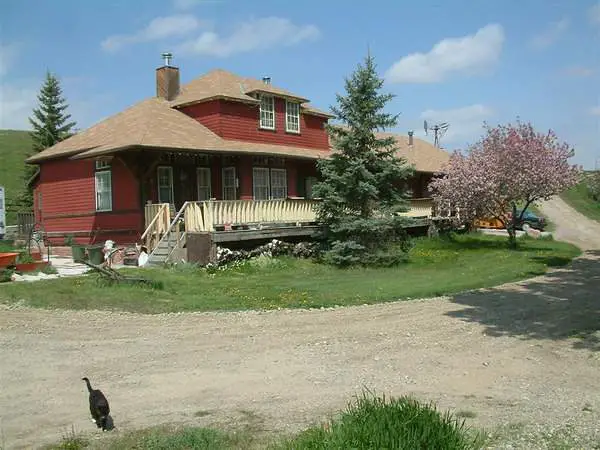 |
CP Station Granum, AB (1904 CPR Station, Model 12) |
| This picture was taken and submitted by Al MacDonald, Granum AB | |
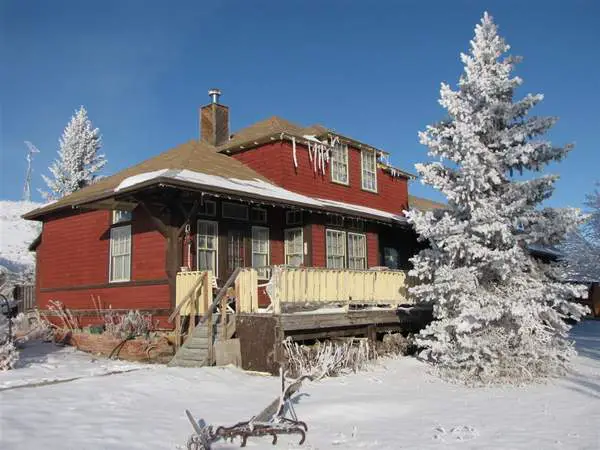 |
CP Station Granum, AB (1904 CPR Station, Model 12) |
| This picture was taken and submitted by Al MacDonald, Granum AB | |
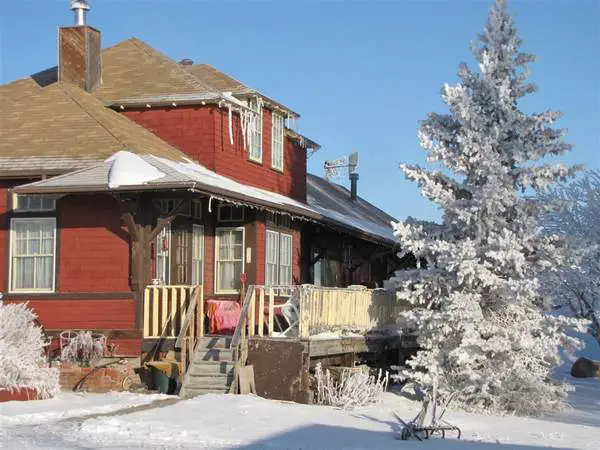 |
CP Station Granum, AB (1904 CPR Station, Model 12) |
| This picture was taken and submitted by Al MacDonald, Granum AB | |
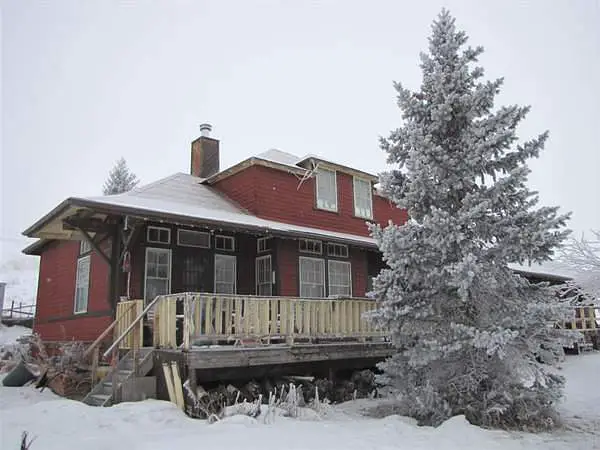 |
CP Station Granum, AB (1904 CPR Station, Model 12) |
| This picture was taken and submitted by Al MacDonald, Granum AB |
| The above station is now the home of Al MacDonald. It was purchased
from the CPR some 36 years ago and moved to it's present location, about
2km from its original site (Granum AB, between Calgary and Lethbridge).
Al has lived in it for the past 20 years.
"The station was modified to make it into a home, and since I've lived here I've tried to make every change more like a CPR station instead of less. Unfortunately my hands are a bit tied in that I don't know exactly what it was supposed to look like. I managed to find an old CPR maintenance shed that I moved onto the property for my hobby machine shop. It's long and skinny like "the house." modified the north end of the building, which was originally the warehouse area (and later converted into a double garage by the previous owner) into my 1-man sewing shop. One day I heard a car door slam and outside were a number of elderly people. I asked if I could help them out and one said they would like to take a picture of the station. "sure, knock yourself out". One of the ladies said she was born in the building and her Dad was the stationmaster for 42 years. She was immediately invited in and we had a great chat. She came back a couple of months later with her sister who was also born in the building. They were like a couple of school girls, looking all around the building and trying to remember where everything was. Very rewarding. |
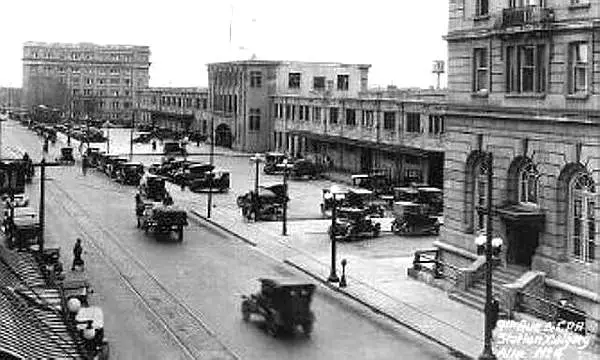 |
The Calgary CPR station on 9 Avenue looking east,
from an old photo in Massey's collection. We could date the photo to about 1910. The passenger
The CPR station was then located in the basement of
To the right of the station is what is now the Fairmount Palliser
Hotel (ex-CPR), which will celebrate its
|
| Submitted by Massey F. Jones |
|
The Canadian Northern Railway (CNoR) station
at
141 18 Ave SW (in the Calgary Mission District) is a locally-quarried three-story sandstone structure constructedin 1905 as a parish hall for the St Mary's RC church next door at a cost of $14,304. It seated 500 and was used as a church community hall for concerts theatrical plays and other functions such as a Ukrainian centre. From 1907 to 1910, the basement served as a classes for the the St. Mary's Boys School. During the real estate boom 1911, the building was sold
In addition to the building, the Canadian Northern
A separate building had been planned as a station but
See my bridge page: http://yourrailwaypictures.com/TrainBridges/index
The bottom pictures show the CNoR station with
|
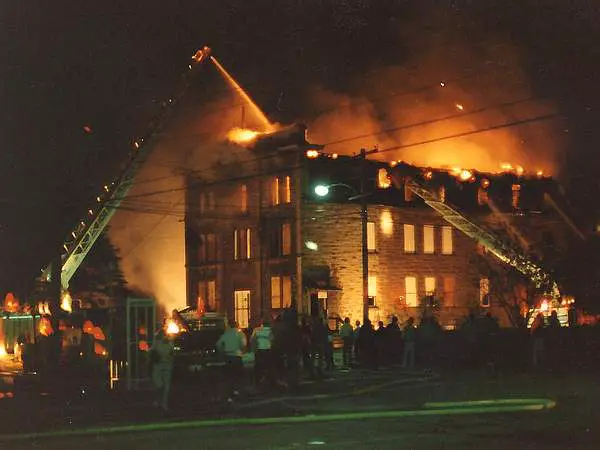 |
CNoR Station Calgary
The first passenger train arrived sometime in the
Around 1984, Calgary City Ballet (now Alberta Ballet)
|
|
| This picture was taken and submitted by Massey F. Jones | ||
 |
The Canadian Northern Railway station at 141 18 Ave SW
in Calgary, after fire damage in August 1985 during renovation. Thanks to funding from The Nat Christie Foundation, the building had been totally rebuilt by 1987, as seen in a companion picture. |
|
| This picture was taken and submitted by Massey F. Jones | ||
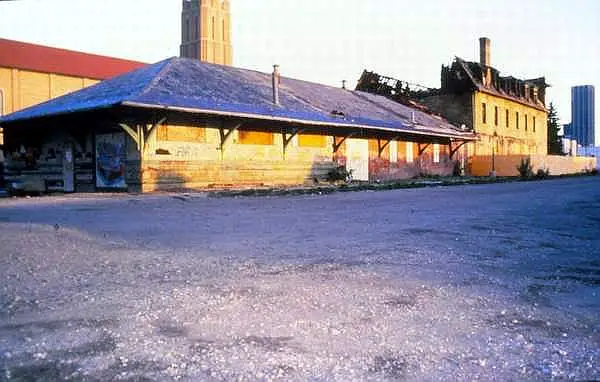 |
Looking northwest.
Compare this view with the photo of the restored building below. |
|
| This picture was taken and submitted by Massey F. Jones | ||
|
|
The first passenger train arrived mid-1915 and improvements
were made to the building by 1916, by adding a trackside canopy and brick express structure (in typical railway architecture). Designed with a "boomtown baroque: classical facade and style reminiscent of French Canadian architecture, the St Mary parish hall was erected in 1905 at a cost of $14,304 and used for social, theatrical and athletic activities. In 1911, the building was purchased by the Canadian
The City of Calgary then acquired the building in 1978 but
The 1916 brick portion in the back now houses the wardrobe
|
|
| This picture was taken and submitted by Massey F. Jones | ||
|
|
A view looking south toward the Elbow River Bridge,
crossed by Canadian Northern Railway (CNorR) locomotives, later CN, until 1971 when the building was abandoned. Beyond the gates in the background are the original tracks, going into what used to be the CNorR yard. They have been preserved into the bridge as an historical artifact. The train, which came into the station facing northbound, was
The bridge (covered later into the "Bridge page") is now part
|
|
| This picture was taken and submitted by Massey F. Jones | ||
|
|
In the background, the refurbished Canadian Northern
Station, used by the Canadian National Railways until 1971 It is now used by the Alberta Ballet and called the Nat Christie Centre. Nat Christie was a Calgary horse breeder and businessman. Note the proximity to the Calgary Tower and Calgary's
|
|
| This picture was taken and submitted by Massey F. Jones | ||
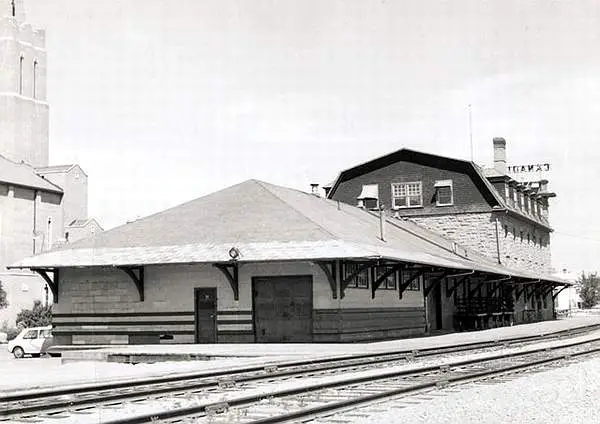 |
The rear of the CNR Station on July 18th 1966,
while still in use. Passenger service was discontinued in 1970 |
|
| Photo: A.H. (Al) Cloverdale through Lorne Unwin Massey F. Jones collection. | ||
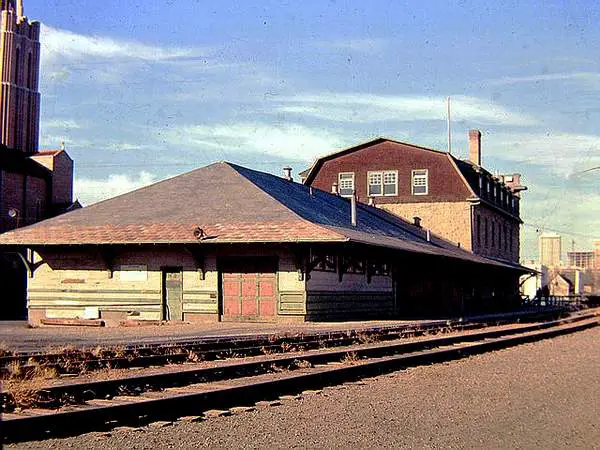 |
Another view of the Canadian Northern Railway
Station freight shed from a colour slide, about 1978-1979, after it was closed but the tracks not yet lifted, following purchase by the City of Calgary. The building was declared a Provincial Historic Site
|
|
| Massey F. Jones collection | ||
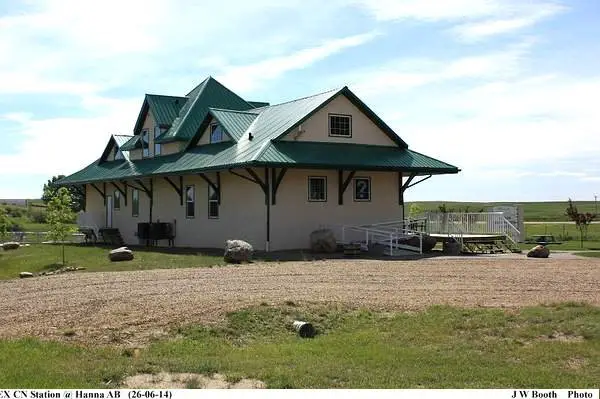 |
CN Station at Hanna, AB, June 26 2014
The former Canadian Northern Railway Station at Hanna was constructed in 1913 and served to provide both passenger and freight service until August, 1990. Due to its historical significance, it was decided to restore and relocate the Station to serve as the Town's new Tourist Center. |
|
| This picture was taken and submitted by Jim Booth, Willingdon AB | ||
.jpg) |
The former CN station at Hanna at 603 South Municipal Road
is now the town's Visitor Information Centre. The building was constructed in 1913 on the Canadian
Hanna is located in East-Central Alberta approximately 2 hours
|
|
| Massey F. Jones collection | ||
.jpg) |
The station at Cereal is now a museum. Cereal is a village in
East Central Alberta established in 1910 near Drumheller by the Canadian Northern Railway (CNoR) now CN, to transport local crops (mainly wheat and barley). Like the Hanna station on this page, it was situated on the Goose Lake Line from Saskatoon to Calgary. The view is dated somewhere in the 70s when the station was being refurbished. See the station in use at https://hermis.alberta.ca/PAA/Photo
An excellent front view in more recent time https://www.
|
|
| Massey F. Jones collection | ||
.jpg) |
Street view from the street of the former Claresholm, Alberta
CPR station at 5126 - 1 Street W, Claresholm on 27 April 1985. It was constructed in 1910-11 from half of the former
The City of Claresholm leased, then purchased the building
|
|
| Massey F. Jones collection | ||
.jpg) |
Trackside view of the former Claresholm, Alberta station
after it became a museum. The track originally connected Calgary to Lethbridge through High River and Fort Macleod as a secondary line. Although the CPR abandoned passenger service in 1965,
|
|
| Massey F. Jones collection | ||
.jpg) |
Trackside view of the former Claresholm, Alberta station after
it became a museum. The track originally connected Calgary to Lethbridge through High River and Fort Macleod as a secondary line. Although the CPR abandoned passenger service in 1965,
|
|
| Massey F. Jones collection | ||
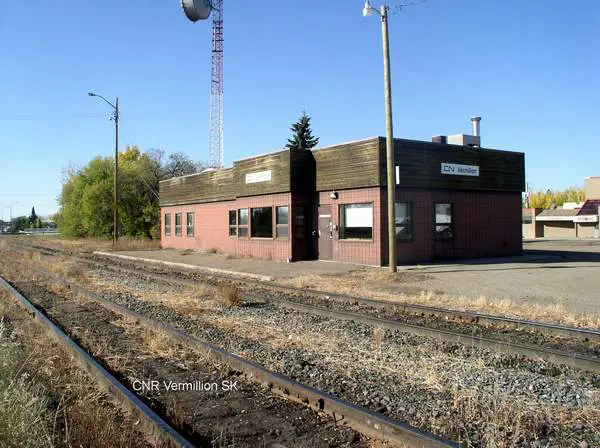 |
CNR Station Vermillion AB
Vermillion AB station. Vermilion AB is the first division point east of Edmonton AB on the old Cdn. Northern main line between Winnipeg and Vancouver. |
|
| This picture was submitted by Arthur Grieve, Winnipeg, Manitoba | ||
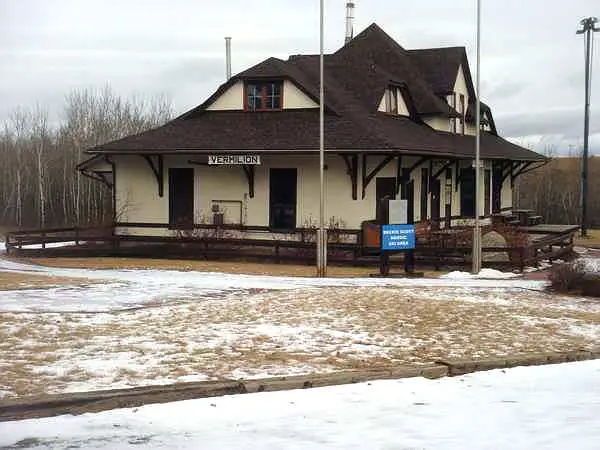 |
CNR Station Vermillion AB
This station was the original Vermillion Station and was moved to a new location in 1987 and is part of a recreational facility |
|
| This picture was taken and submitted by Gary Paul | ||
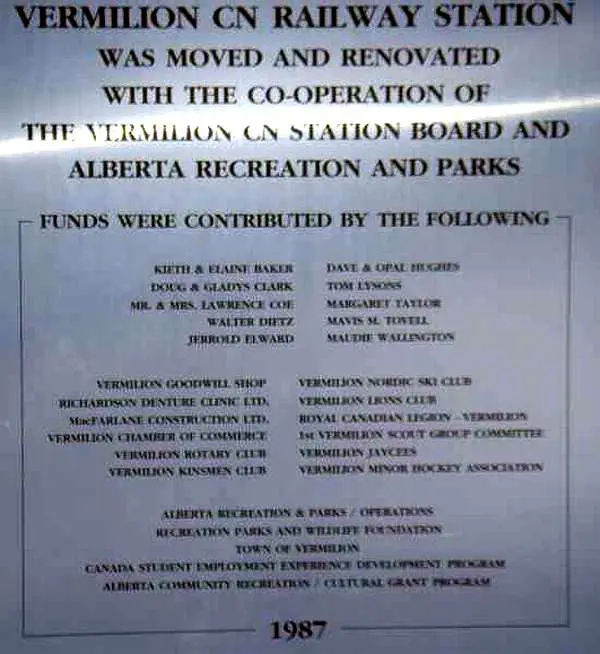 |
A Plaque showing the contributors to the moving of the
Vermillion Station |
|
| This picture was taken and submitted by Gary Paul | ||
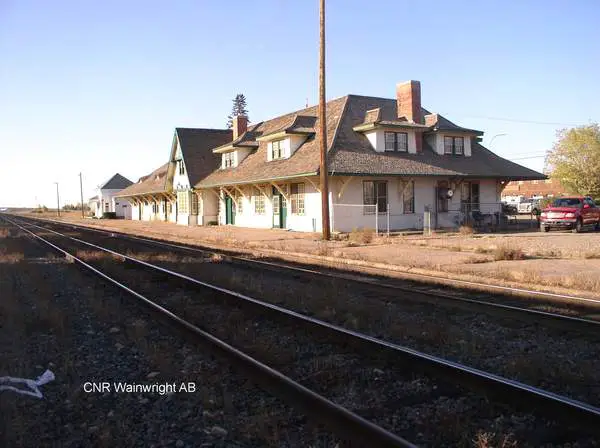 |
CNR Station Wainwright AB
Wainwright AB is the first division point east of Edmonton on what was once the main line of the Grand Trunk Pacific Rwy's between Winnipeg and Prince Rupert. This line is now the main line of the CNR between Winnipeg, Vancouver and Prince Rupert |
|
| This picture was submitted by Arthur Grieve, Winnipeg, Manitoba | ||
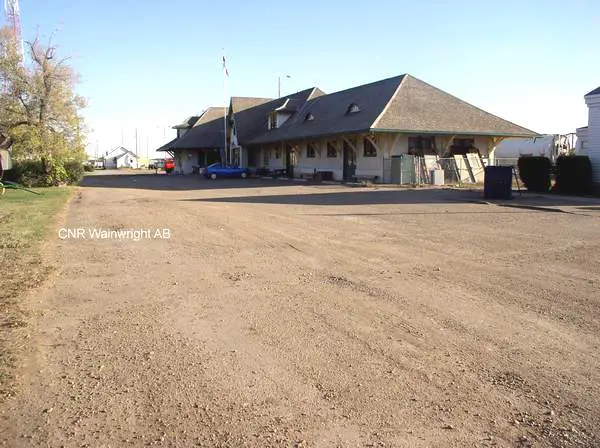 |
CNR Station Wainwright AB | |
| This picture was submitted by Arthur Grieve, Winnipeg, Manitoba | ||
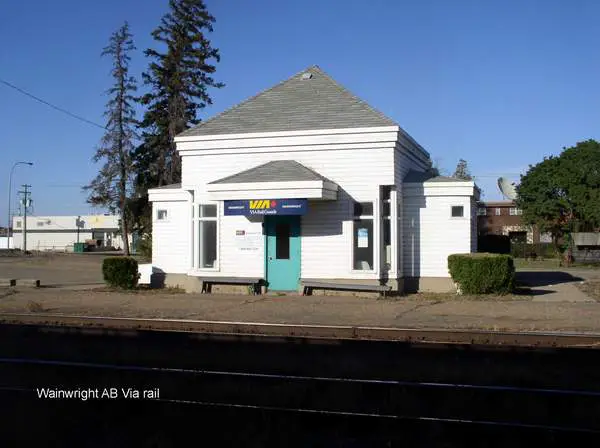 |
Via Station Wainwright AB | |
| This picture was submitted by Arthur Grieve, Winnipeg, Manitoba | ||
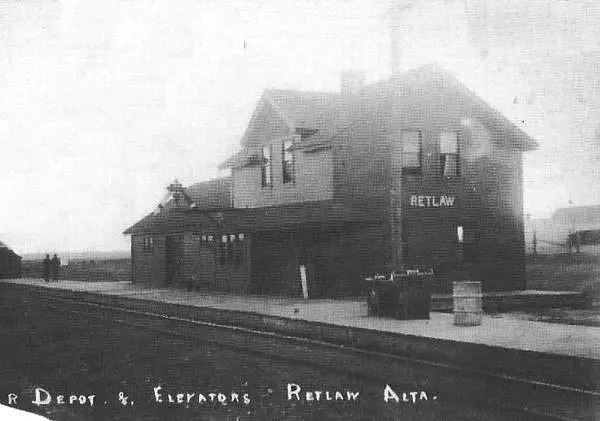 |
CPR Station Retlaw AB. | |
| c.1920's. Courtesy of the Retlaw historical society. | ||
| This picture was submitted by Arthur Grieve, Winnipeg, Manitoba | ||
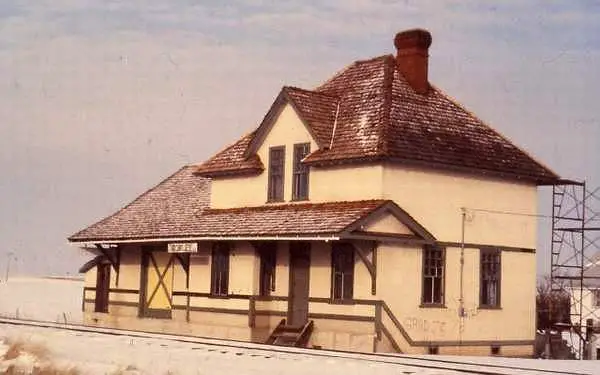 |
exCNoR Station Rowley AB
Rowley station undergoing renovations prior to 1989 and
Rowley station is now, believed to be virtually abandoned..
|
|
| This picture was taken and submitted by Massey F. Jones | ||
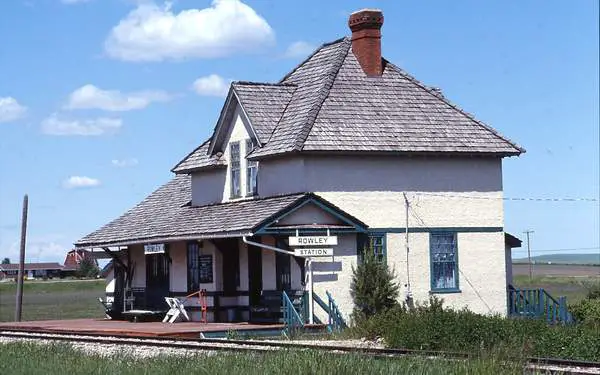 |
Rowley station undergoing renovations prior to 1989
and use on the Alberta Prairie excursions. |
|
| This picture was submitted by Dale Redekopp St. Albert, AB | ||
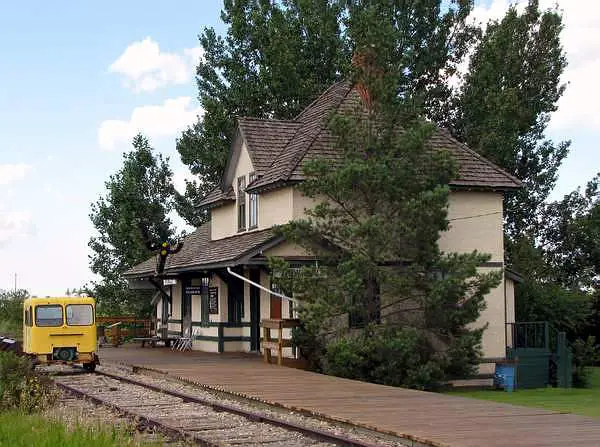 |
exCNoR Station Rowley AB Note the pine tree beside the station. This picture was taken on August 2010 |
|
| Photo: L. Unwin collection This picture was submitted by Massey Jones | ||
.jpg) |
The former station at MIRROR, northeast of Red Deer,
in Central Alberta. The building was constructed in 1911 to serve the
Stucco cement was applied to the outside of the station in
This photo is undated but most probably taken in the
|
|
| Massey F. Jones collection | ||
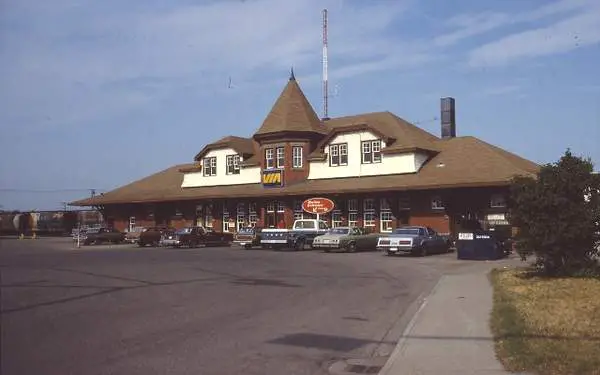 |
CPR (VIA) Station Red Deer AB
This station is no longer in use as such, after VIA withdrew
|
|
| This picture was taken and submitted by Massey F. Jones | ||
.jpg) |
CPR Station Red Deer AB
A trackside view taken October 1989. The rail no longer runs adjacent to the station, as a new CPR yard was constructed to bypass the city, while this photo was being taken. The station was abandoned shortly thereafter and sat deserted. In May 1991, the station was designated as a municipal heritage resource by Red Deer City council. The Province of Alberta made it a Provincial Historic Resource in April 1993. In 1995, the station was purchased by a private concern, restored to its former appearance and now houses law and real estate offices. |
|
| This picture taken and submitted by Massey F. Jones | ||
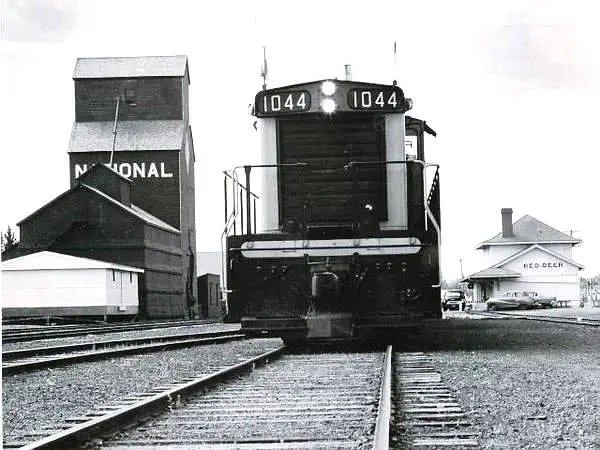 |
The CN Station at Red Deer Alberta to the right,
built in 1923 and demolished in 1960. It had ticket office, waiting rooms, toilets, baggage and express and the second floor was the agent's residence. The last regular train used the station in 1955. After CN relocated its tracks more to the north, the station land was redeveloped as the Co-Op shopping Centre. Since the GMD-1 was built in 1959 and the station demolished in 1960, we have to date the photo to that period. |
|
| Massey F. Jones collection | ||
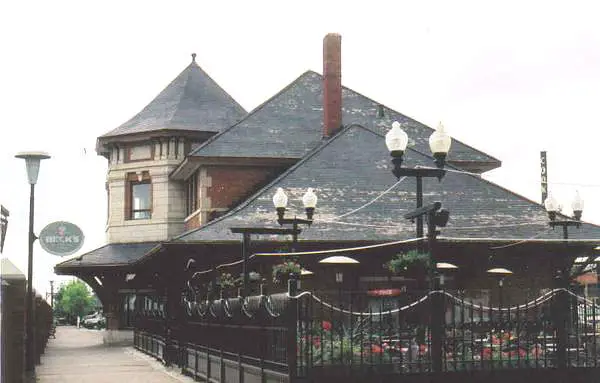 |
Former CP C&E South Edmonton, AB
Now The Iron Horse Restaurant and Bar |
|
| This picture was submitted by Dave Savage/CRSN www.railwaystationnews.ca | ||
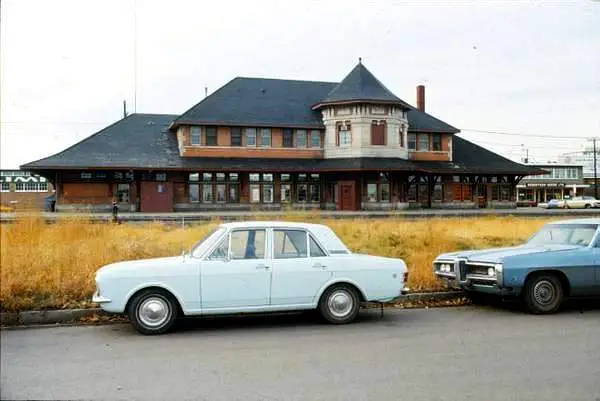 |
A clear trackside view of the South Edmonton (Strathcona) CPR/VIA station, about mid-70s. | |
| Massey F. Jones collection | ||
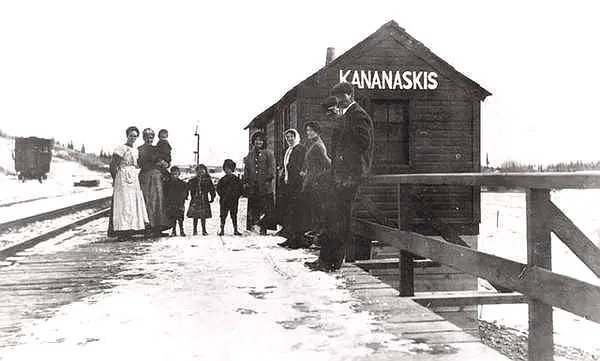 |
The CPR Flag Stop at KANANASKIS, a short 50 miles
west of Calgary, near Canmore, Alberta in the Canadian Rockies This is a perfect example of a portable station just dropped trackside by the CPR, with a bit of additional construction afterwards. |
|
| Glenbow Archives � Massey F. Jones collection | ||
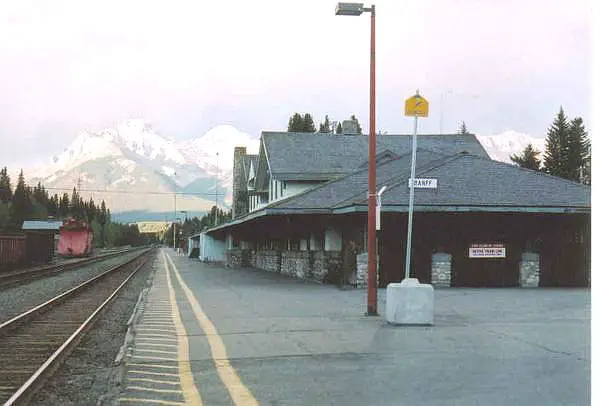 |
CP Banff, AB Now a Restaurant and Tourist Train Station | |
| This picture was submitted by Dave Savage/CRSN www.railwaystationnews.ca | ||
.jpg) |
A street view of the CPR/VIA station at Banff, Alberta
early '80s. "The Caboose" restaurant to the right has since gone out of business. |
|
| Photo: Massey F. Jones | ||
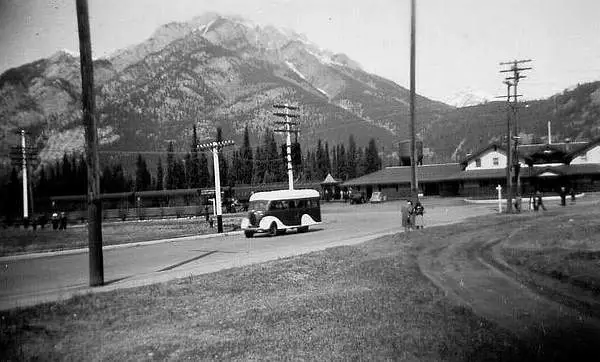 |
CPR Banff AB Station, 1942
This picture was taken by Tim Croft's The picture was taken by his father in law, Sydney Taylor in 1942 when he was on his way to Raf Penhold (Red Deer AB) flight training school. |
|
| The picture was submitted by Tim Croft from the UK. | ||
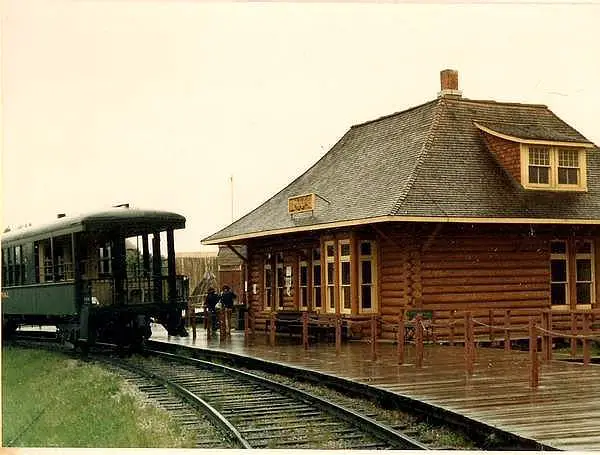 |
CPR Laggan Station. This was the original
Lake Louise Station This picture was taken between 1977 and 1985 This station was moved to Calagary's Heritage Park in 1976 |
|
| This picture was take and submitted by Etienne Ozorak, Sacramento, California | ||
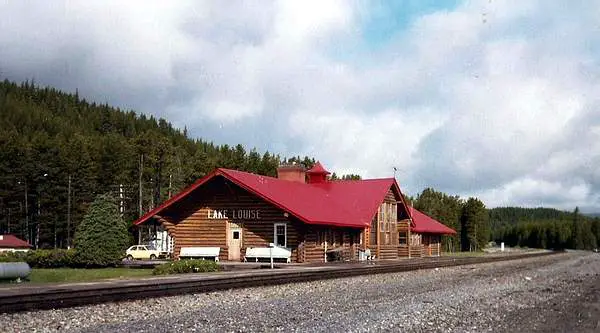 |
CPR Lake Louise Station
This picture was taken between 1977 and 1985 |
|
| This picture was take and submitted by Etienne Ozorak, Sacramento, California | ||
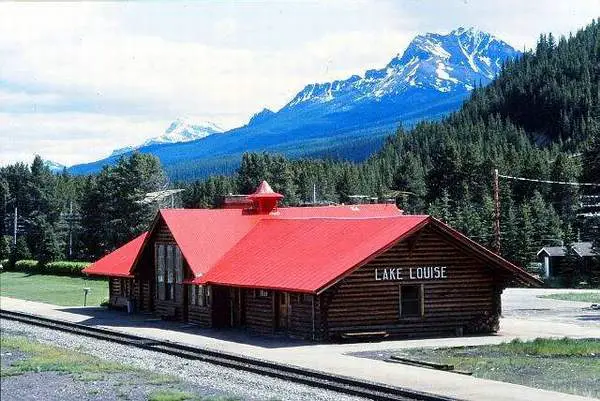 |
CPP Lake Louise station, when it was still in use in the mid-80s
when this photo was taken, as evidenced by the
arrivals/departures sign still affixed to the wall. This view looks east from the "High Line", a slight grade
Still in use today, the former station is now converted to an
|
|
| This picture taken and was submitted by Massey F. Jones | ||
.jpg) |
Lake Louise Station looking west in the late-70s, see the
VIA sign on the door. The station was the second building erected on the site, the
|
|
| This picture taken and was submitted by Massey F. Jones | ||
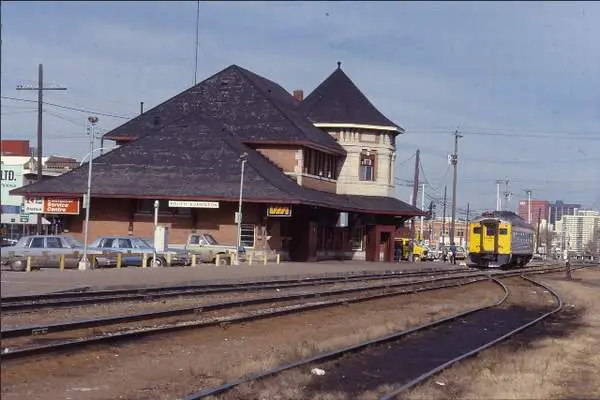 |
South Edmonton VIA Station formally
The Strathcona Canadian Pacific Railway Station The Strathcona Canadian Pacific Railway Station was built by the Calgary and Edmonton Railway in what was then the City of Strathcona, Alberta. It was started in 1907, completed in1908, and expanded in 1910, and is located at what is now 8101 Gateway Boulevard, just south of Whyte Avenue.The building was initially the northern terminus of the Calgary and Edmonton Railway serving Strathcona and Edmonton, although Canadian Pacific later expanded that line north across the North Saskatchewan River via the High Level Bridge into Edmonton proper. The building was designated a Canadian Heritage Railway Station in 1991,when it was still owned by CP and therefore subjectto federal regulation. After being sold by CP it was designated a Municipal Historic Resource in 2003, and a Provincial Historic Resource in 2004 Since 1998, the building has been home to the
I
|
|
| This picture taken and was submitted by Massey F. Jones | ||
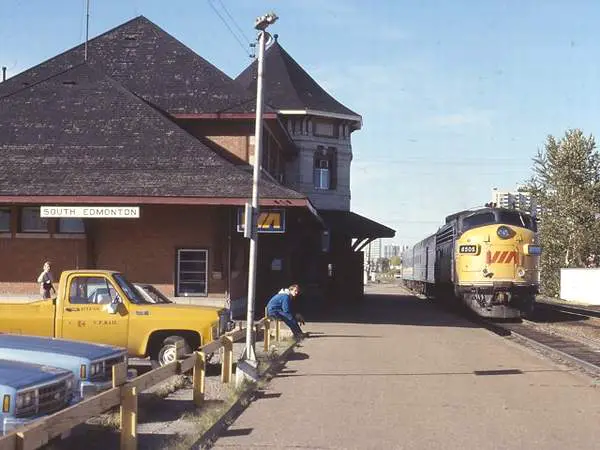 |
South Edmonton VIA Station
This is a rare event, as the RDC had
a problem and an FP unit
|
|
| This picture taken and was submitted by Massey F. Jones | ||
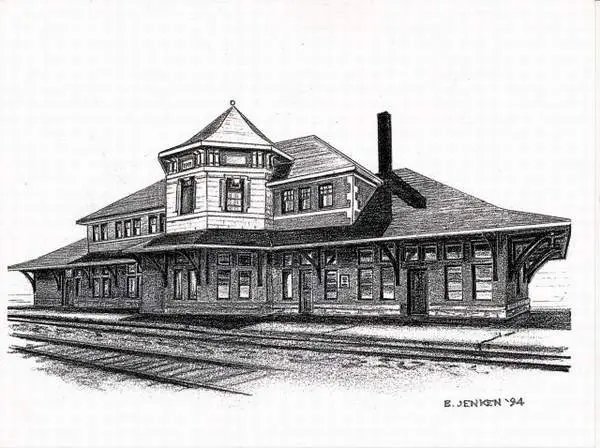 |
A good sketch of the CPR Strathcona station in
South Edmonton, described fully on this page. |
|
| Massey F. Jones Collection | ||
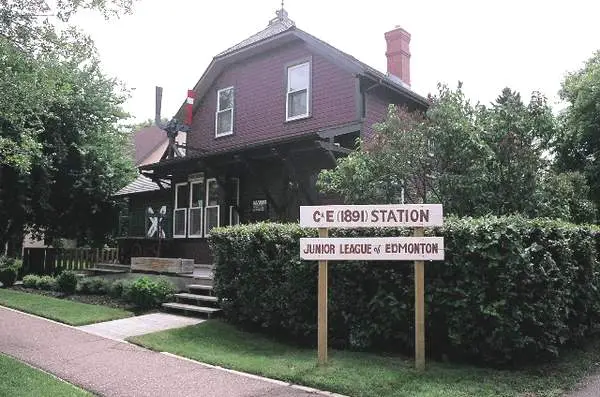 |
Calgary & Edmonton Railway Station, Edmonton, Alberta
The building (now a museum) at 10447-86 Ave, is a replica of the
original station which served Edmonton from 1891-1907 and
|
|
| This picture taken and was submitted by Massey F. Jones | ||
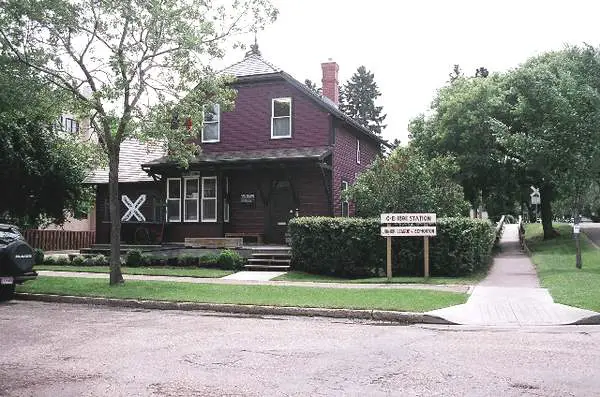 |
Calgary & Edmonton Railway Station, Edmonton, Alberta
Behind the building by the crossbucks is the the old CPR line to
Currently, the Edmonton Railway Society (ERRS) runs one of
Operations take place from the May Long wekend to (Canadian)
Thanksgiving weekend (May-October).
Close to 50,000 passengers are carried in an average year
|
|
| This picture taken and was submitted by Massey F. Jones | ||
.jpg) |
CNoR (CN) Viking station at 5001 51 Avenue,
Viking, Alberta |
|
| Massey F. Jones Collection | ||
.jpg) |
The baggage shed end of the former CNoR (CN)
Viking station at 5001 51 Avenue, Viking, Alberta |
|
| Massey F. Jones Collection | ||
.jpg) |
Situated half-way between Calgary and Red Deer at mileage
46.4 CP Red Deer Sub, Didsbury station was built in 1904 to replace a temporary structure and the addition built in 1907. It was first used by the Calgary & Edmonton Railway (C&E) and later the CPR. The building was retired in 1977 and donated to the town in
|
|
| Massey F. Jones collection | ||
.jpg) |
A close-up of the former Didsbury, Alberta CPR station.
A good side view of the main building is at: http://en.wikipedia.org/wiki/Didsbury,_Alberta#mediaviewer
The Red Deer Sub between Calgary and Edmonton runs
|
|
| Massey F. Jones collection | ||
.jpg) |
The Delburne, Alberta station was built in 1911 by the
Grand Trunk Pacific (GTP) as a Type E station, like many in the area. The wood siding (common with stations of the day), was coated with stucco in 1922. With discontinuation of passenger service to the area in 1971, the station fell into disuse and stood vacant for several years. It was then moved a few blocks and became part of the Antony Hendy Museum in 1978, along with a water tower and other artifacts. Some of the artifacts are housed in the water tower. The museum is located east of Red Deer AB on off
|
|
| This picture taken and was submitted by Massey F. Jones | ||
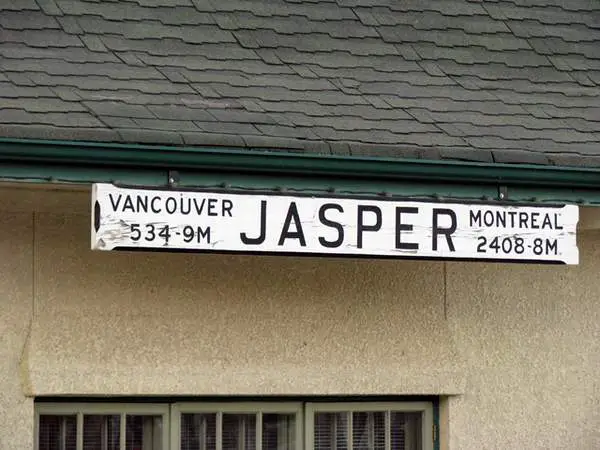 |
The station sign on each side of the former CN (now VIA Rail) station at Jasper, Alberta. The station serves transcontinental passengers each way 3 times a week and also those, to and from Prince Rupert BC. The Rocky Mountaineer also uses it during summer as a terminal to and from Vancouver via Kamloops. | |
| This picture taken and was submitted by Massey F. Jones | ||
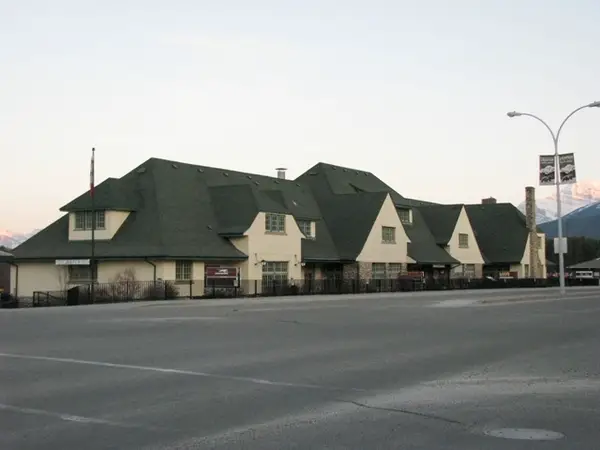 |
The VIA station at 607 Connaught Drive in downtown Jasper, Alberta
has been serving passengers since it was constructed by the CNR in 1926.
This view looks east in June 2009. |
|
| This picture taken and was submitted by Massey F. Jones | ||
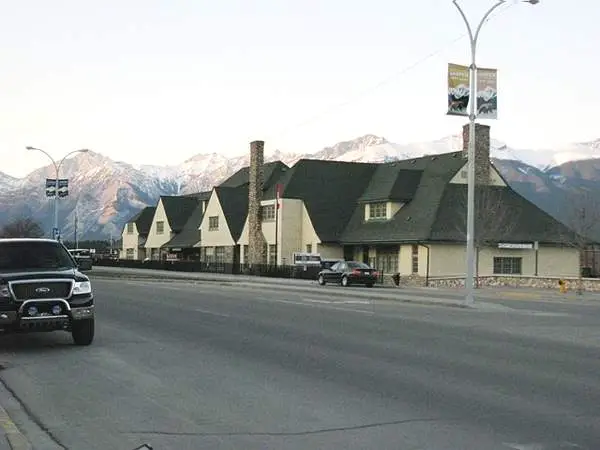 |
Jasper station, situated in the National Park of the same
name, was declared a heritage railway station by the federal government in 1992. This view looks west from the other side of Connaught Drive in June 2009. |
|
| This picture taken and was submitted by Massey F. Jones | ||
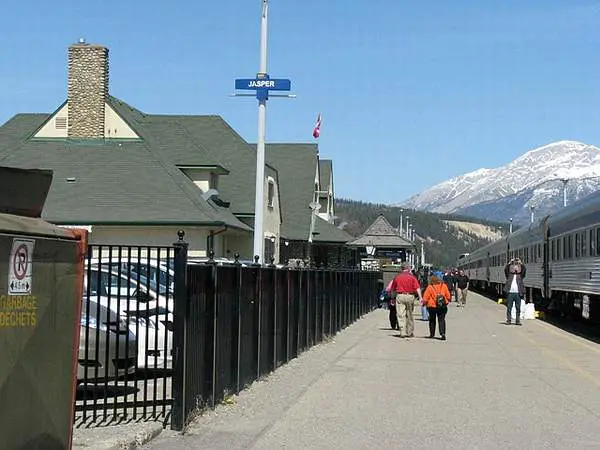 |
Jasper VIA Station trackside.
The photo was taken May 1st, 2009
View the "Canadian", led by VIA 6419 and
Massey and wife subsequently boarded the train to
|
|
| This picture taken and was submitted by Massey F. Jones | ||
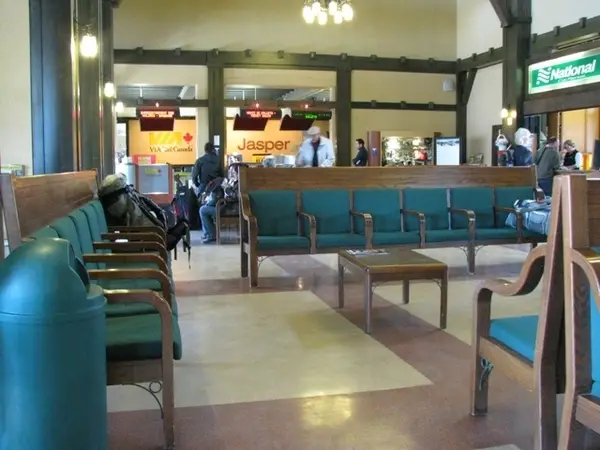 |
CN Jasper Station Interior showing the
VIA Counter, June 2009 |
|
| This picture taken and was submitted by Massey F. Jones | ||
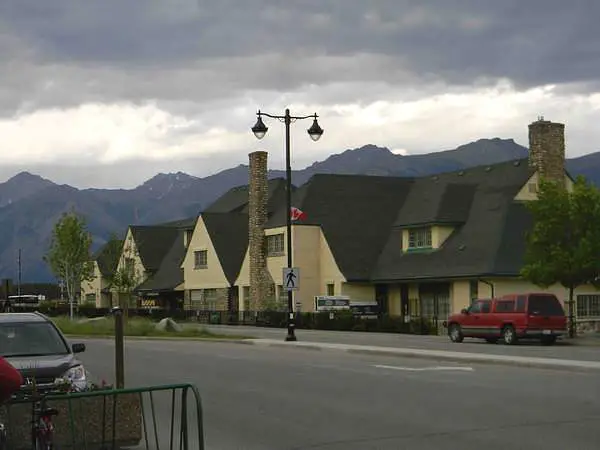 |
CN/VIA Jasper Station July 2011 | |
| This picture was taken and submitted by Corey Walker, Prince George, BC | ||
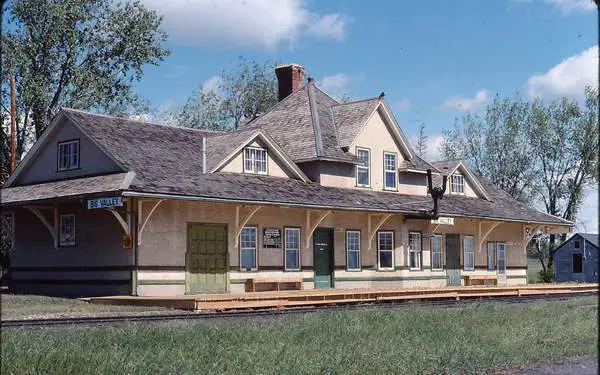 |
Big Valley Station
This station islocated in central Alberta. The Village of
|
|
| This picture taken and submitted by Massey F. Jones | ||
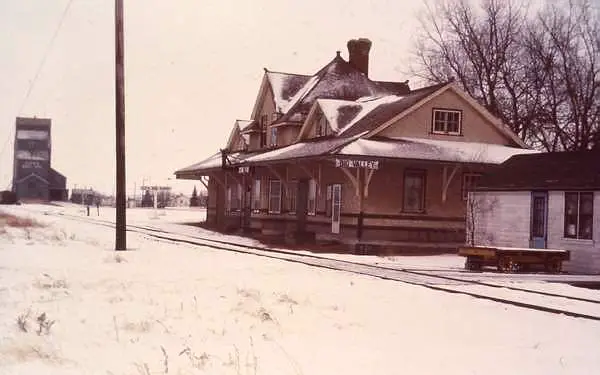 |
Big Valley CN station, 32 km south of Stettler AB, as
it
was in 1989 prior to preservation by the Canadian Northern Society and use by the Alberta Prairie Railway Excursions. The adjacent roundhouse ruin, shown below is on the list of Canada's Historic Places. |
|
| Photo: L. Unwin Submitted, Collection Massey F. Jones | ||
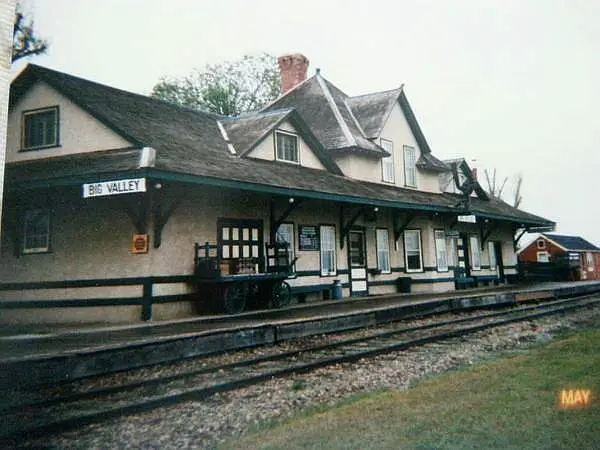 |
Big Valley CN station, taken in May 1997 | |
| This picture was taken and submitted by Wayne Anderson, Lethbridge Alberta | ||
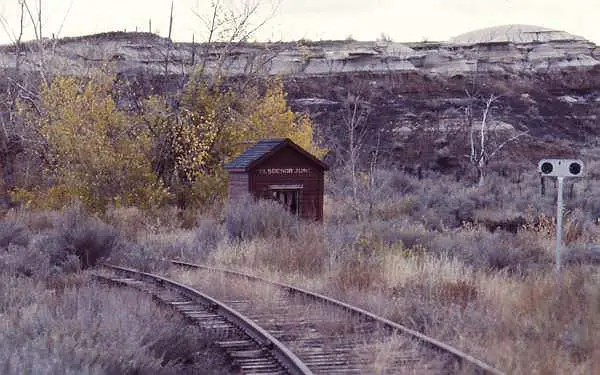 |
ELSDESOR Junction, near Drumheller AB in the Badlands
area, which is 75 million years old. The proper name should have been "Eladesor", which is
The railway served the Atlas Coal Mine, a wooden tipple,
The whole area and attractions are described at:
|
|
| This picture was taken and submitted by Massey F. Jones | ||
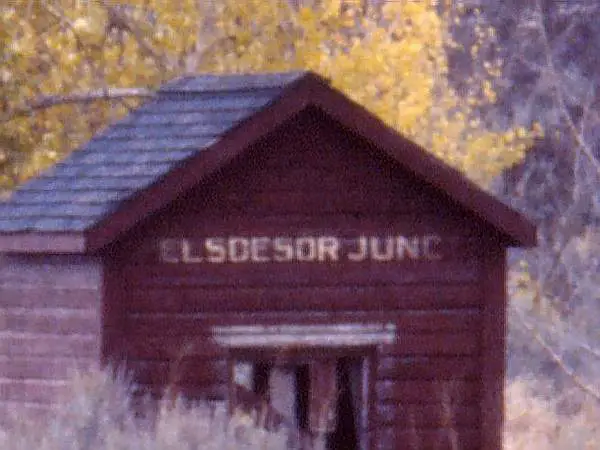 |
||
| This picture was taken and submitted by Massey F. Jones | ||
|
|
The CPR Pavilion over 1st St SW in downtown Calgary, is
where passengers can board the Empress 2816 and the Royal Canadian Pacific luxury train. Passengers staying at the multi-star Fairmount Palliser Hotel on the left can connect directly to the "Great Hall" boarding area to the right, through the glassed portion. The pavilion is built on a bridge that supported the first construction train west in 1885. The Royal Canadian Pacific offices at 201 9th Ave SW, to the right, were formerly occupied by the Calgary headquarters of Canada Post. The building was totally gutted and rebuilt to modern standards, complete with an upscale waiting area and historic CPR railway artifacts on the first floor |
|
| This picture was taken and submitted by Massey F. Jones | ||
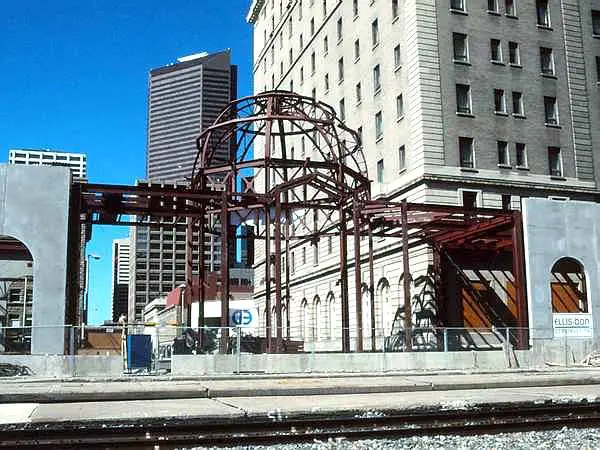 |
The skeleton of the Canadian Pacific Great Hall rotunda;
seen from the back on July 23rd, 1999 during construction. The Great hall, seen elsewhere on the page, is to the left. This view looks north towards the downtown core and the
|
|
| This picture was taken and submitted by Massey F. Jones | ||
|
|
A view from the inside of the Great Hall of the
Royal Canadian Pacific, showing part of the 12 meter high glass rotunda, built around 2000 over an existing street bridge. Reflected in the glass to the right is the adjacent Palliser Hotel to the left, which accommodates the RCP guests prior to departure. The Great Hall is connected directly to the hotel for catering and guest departure. |
|
| This picture was taken and submitted by Massey F. Jones | ||
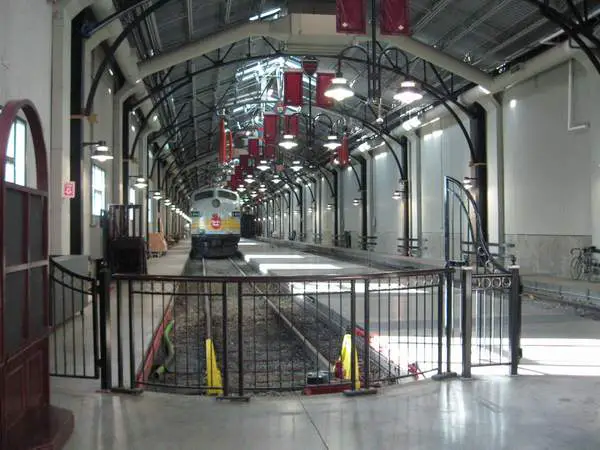 |
Canadian Pacific Railway FP7 1401 (GMD 1953)
"The Great Hall", a 152m wing (just short of 500 ft), where
The area can accomodate up to 80 people for seated dining
|
|
| This picture was taken and submitted by Massey F. Jones | ||
|
|
The wrought iron artwork under the CPR Pavilion
in 1st St SW underpass. |
|
| This picture was taken and submitted by Massey F. Jones | ||
|
|
The wrought iron artwork under the CPR Pavilion
in 1st St SW underpass. |
|
| This picture was taken and submitted by Massey F. Jones | ||
|
|
The wrought iron artwork under the CPR Pavilion
in 1st St SW underpass. |
|
| This picture was taken and submitted by Massey F. Jones | ||
|
|
The wrought iron artwork under the CPR Pavilion
in 1st St SW underpass. |
|
| This picture was taken and submitted by Massey F. Jones | ||
|
|
The citations are clipped to the side of the
Royal Canadian Pacific offices. |
|
| This picture was taken and submitted by Massey F. Jones | ||
|
|
The citations are clipped to the side of the
Royal Canadian Pacific offices. |
|
| This picture was taken and submitted by Massey F. Jones | ||
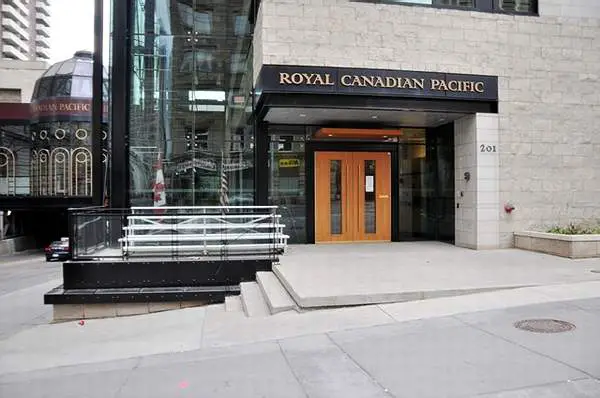 |
The Royal Canadian Pacific Station at 201 - 9th Avenue
SW in Calgary, a block west of the Calgary Tower. The Royal Canadian Pacific is a luxury train accommodating
Entering the station door and turning right leads into the
Trips are always carried in daylight, with overnight stops at
The Royal Canadian Pacific train features restored FP9
|
|
| This picture was taken and submitted by Massey F. Jones | ||
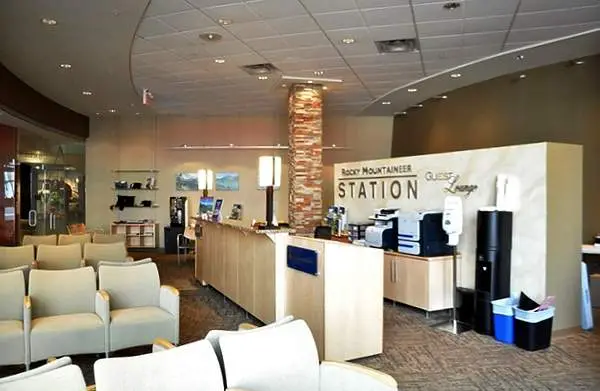 |
Just off the street east of the main entrance at the base of
the Calgary Tower on 9 Ave x Centre Street is the Rocky
Mountaineer Station. Notice the Tower curvature. Next to the Royal Canadian Pacific luxury trip, the Rocky Mountaineer
is the best choice, from Calgary to Vancouver
While stored in Calgary, trains normally head straight to
|
|
| This picture was taken and submitted by Massey F. Jones | ||
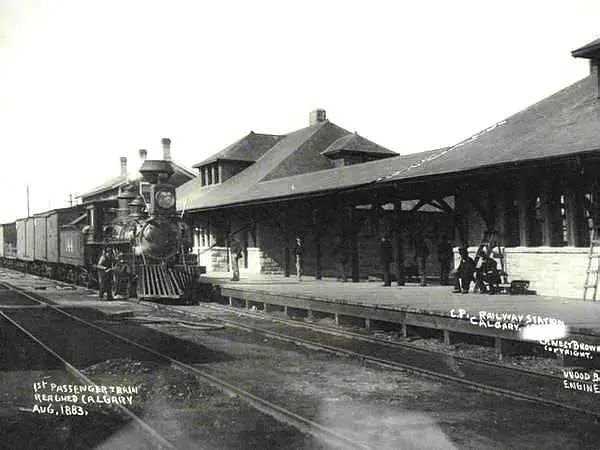 |
CPR # 144 at Calgary station.
The caption states that the first passenger train reached Calgary Aug 1883. This is the second station in Calgary (the first was a boxcar). Both buildings were eventually taken down when a much larger station was built a block further west. One building then became the High River CPR station, the other the Claresholm CPR station, both a few miles south of Calgary. On 28 Jul 2010, the High River station (now Museum of the Highwood) sustained fire damage Click here to view more of this station and others that are
|
|
| This pictures is from a framed photograph in a Calgary restaurant.
It was submitted by Massey F. Jones |
||
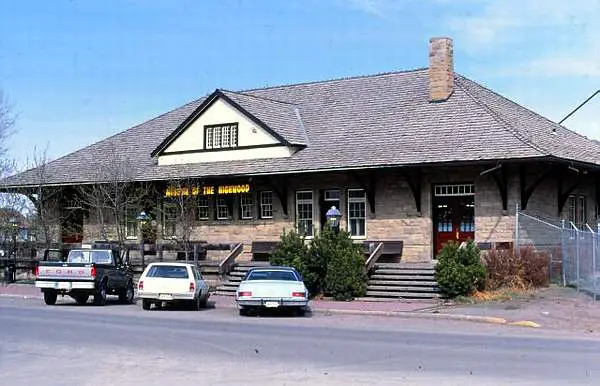 |
The former CPR station, at 406 � 1 Street SW in
High River, Alberta on May 5th, 1989, now called "Museum of theHighwood" after the local river. Constructed to replace a wooden station in 1911, the station
As a result of freight operation having moved to Lethbridge,
The Museum of the Highwood (housing mostly early
|
|
| This picture was taken and submitted by Massey F. Jones | ||
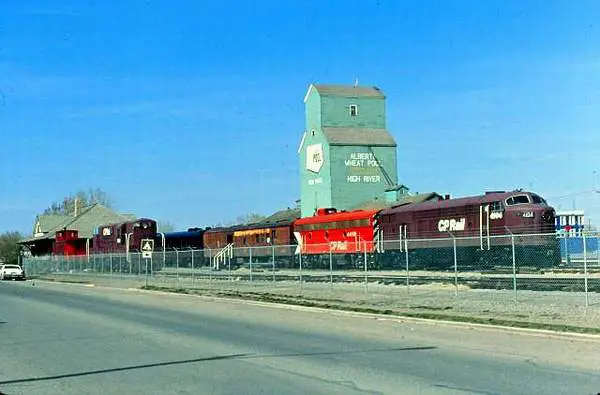 |
The rail display adjacent to the Museum of the
Highwood (former High River CPR Station) on 5 May 1989, has now totally vanished. The station is to the far left. FM "C-Liner" CP 4104 and "Baby Trainmaster" CP 7009 are now in Nelson BC, as representatives of the Fairbanks -Morse locomotives, previously operated in the area and s erviced in the Nelson shops and will become part of a project dubbed: "Railtown" http://www.nelsonstar.com/news/ 181686501.html F7B CP 4459, here in red, can now be viewed in maroon at http://www.mountainrailway.com/Roster%20 Archive/CP%204400A/CP%204459.htm |
|
| This picture was taken and submitted by Massey F. Jones | ||
 |
|
|
| This picture was taken and submitted by Massey F. Jones | ||
 |
The waiting room, which had become woefully
inadequate in latter years, with passengers and visitors standing almost elbow to elbow. |
|
| This picture was taken and submitted by Massey F. Jones | ||
 |
The baggage area. With more and more visitors opting
for a train trip through the Rockies, needless to say that the station wasn't your typical hometown railway station. |
|
| This picture was taken and submitted by Massey F. Jones | ||
 |
The counter area. The station would close within the
week and most of the publicity (posters etc.) around the counter had been removed. |
|
| This picture was taken and submitted by Massey F. Jones | ||
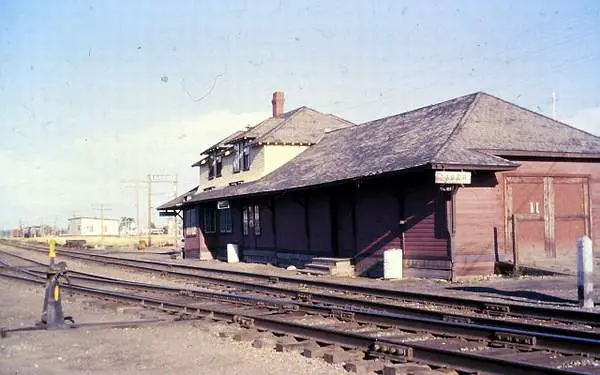 |
Taber AB CPR Station, 123 miles from Calgary, near
Lethbridge. Taber is the corn capital of Canada "Taber corn" is a sweet variety, highly prized by Albertans. Originally, Taber was known as "Tank No. 77," and was used by the railway to fill up on water. In 1903, it is said that the first Mormon settlers from the U.S.A. were the ones to establish a hamlet at the Tank. After the town's post office was built in1907, the CPR decided to call thetown "Tabor," probably after Mount Tabor in the Holy Land. However, various letters and station heads came out printed "Taber," so the CPR changed the name to make it match the records.An alternate version of the towns name origin is that the first part of the word tabernacle was used by Mormon settlers in the vicinity, and the next Canadian Pacific Railway station was named Elcan (nacle spelled backwards). (Description from Wikipedia) |
|
| Photo: L. Unwin collection This picture was submitted by Massey Jones | ||
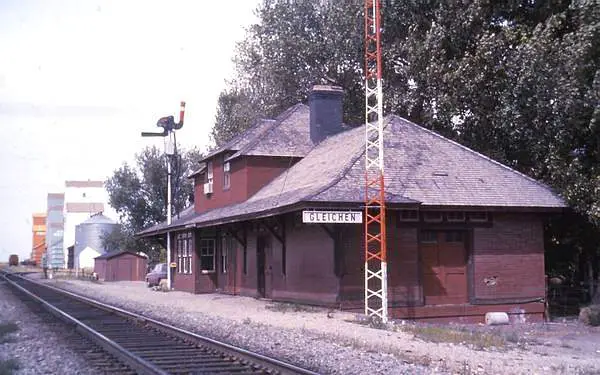 |
Gliechen AB CPR Station, located 90km
East of Calgary |
|
| This picture was taken and submitted by Massey F. Jones | ||
.jpg) |
The former CN station at Hanna at 603 South Municipal
Road is now the town's Visitor Information Centre. The building was constructed in 1913 on the Canadian
Hanna is located in East-Central Alberta approximately
|
|
| Massey F. Jones Collection | ||
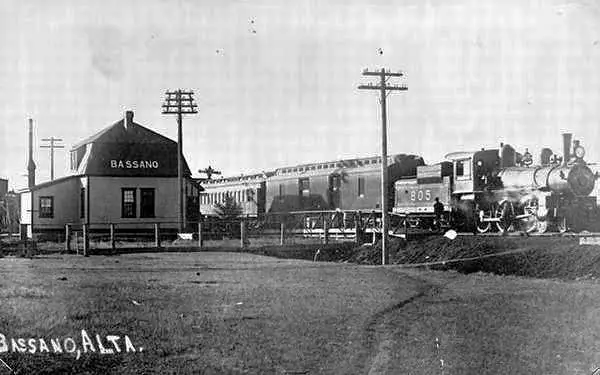
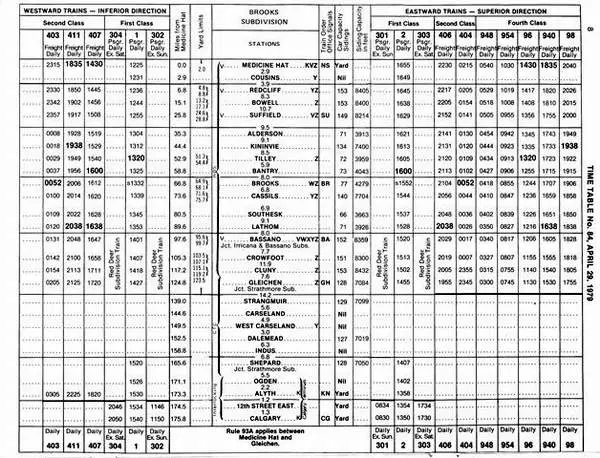
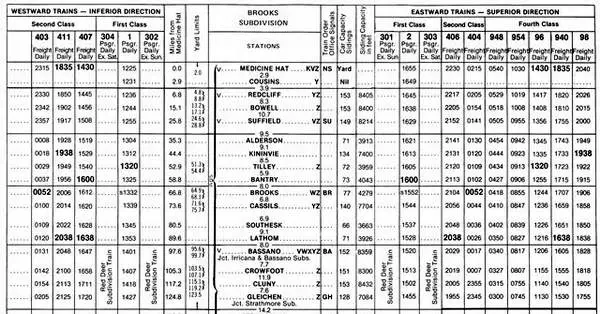 |
A CPR train stops at Bassano, Alberta; early 1900s
shortly after the station opened. The town is located just off the Trans-Canada Highway, 140km east of Calgary and 160km west of Medicine Hat on the #1 Highway and named after the Italian Marquis de Bassano, a Canadian Pacific Railway financial backer during the mid-1800s and construction west into to Calgary. The station is a Canadian Pacific Standard #2 Station,
Following the termination of VIA service into southern
More on the station: http://www.bigdoer.com/11995/exploring-history/
|
|
| Massey F. Jones collection | ||
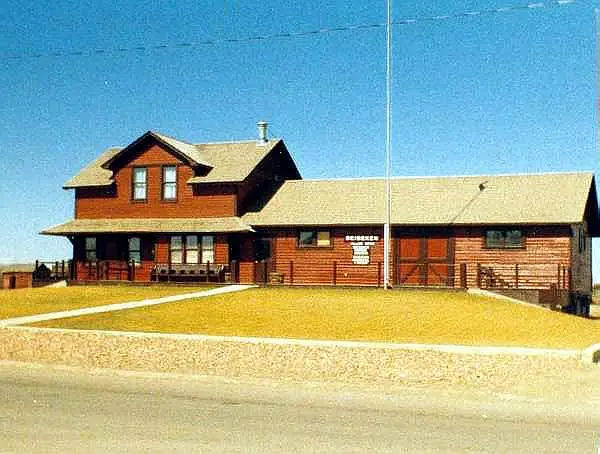 |
CPR Beiseker station at 700, 1st Avenue,
Beiseker, Alberta The CPR station was decommissioned fifty years ago and sat deserted for twenty-five years. In 1980 the Village of Beiseker recognized the historical importance and value of the building and took steps to preserve and restore it. This building is a one-and-a-half storey structure with the distinctive design characteristic of CPR train stations. This building stands prominently at the west end of the village's main street. It was moved from the CPR track-way, turned 180 degrees and placed on a proper foundation on adjacent Village of Beiseker property. It now serves the village as the Municipal Office, the Municipal Library, and the Beiseker Station Museum (description from Historic Places.ca) Visitors can come to the museum year round during Village Office hours. A curator is available to give tours during July and August. Adjacent to the station is an EV caboose in fresh CP yellow paint. |
|
| This picture was taken and submitted by Massey F. Jones | ||
.jpg) |
A pen and ink drawing of the Beiseker, Alberta
station in 1915; from a small framed photograph, most probably displayed in their Station Museum, at 700, 1st Avenue.There are also has several other railway artifacts on site. http://www.beiseker.com/municipal-museum/ |
|
| Massey F. Jones collection | ||
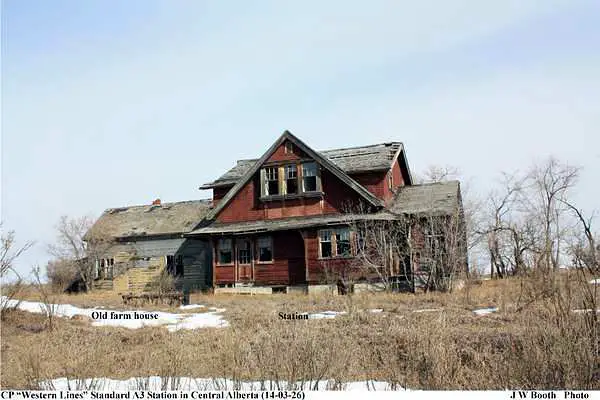 |
CPR Western Lines "Standard A3 Station" in Central Alberta
March 26, 2014 |
|
| This picture was taken and submitted by Jim Booth, Willingdon AB | ||
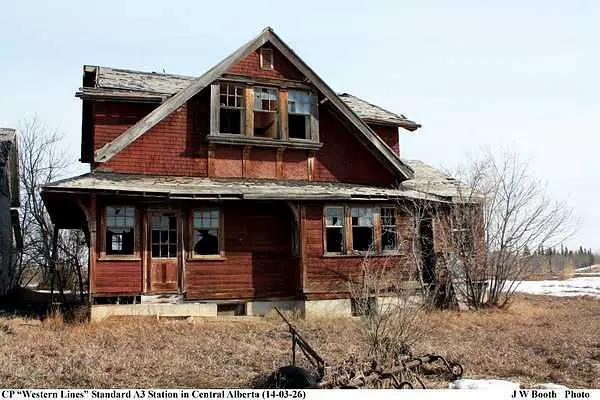 |
CPR Western Lines "Standard A3 Station" in Central Alberta
March 26, 2014 I'll let Jim tell yuo how he got these pictures. "The station sitting on a farm about 70K from here. The station was cut into two parts before being moved. The office/quarters end was placed on a concrete footing, & the freight room section was placed on the ground about 150 feet away. Both pieces still exist! >From what I have learned that the office /quarters section was going to be made into a home. As you can see it never happened. It was about two weeks ago that I learned of it's existence while
I was visiting the local town hall. I was also told that their was not
a hope in hell that I could get on the property to photograph it.
|
|
| This picture was taken and submitted by Jim Booth, Willingdon AB | ||
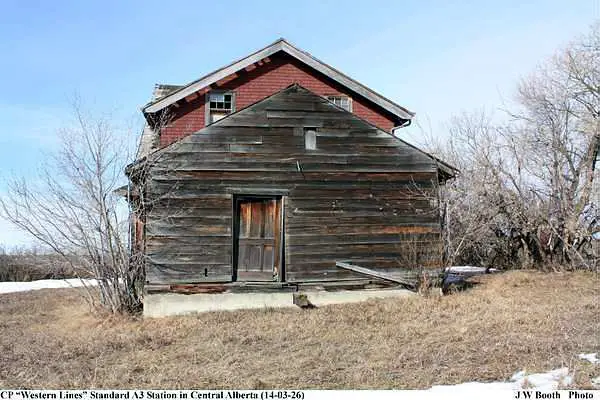 |
CPR Western Lines "Standard A3 Station" in Central Alberta
March 26, 2014 |
|
| This picture was taken and submitted by Jim Booth, Willingdon AB | ||
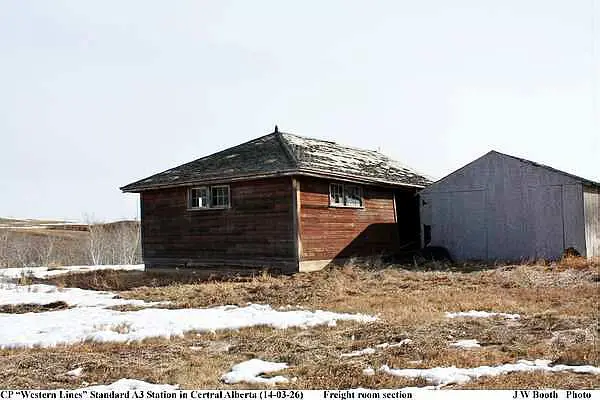 |
CPR Western Lines "Standard A3 Station" in Central Alberta
Frieght room Section. March 26, 2014 |
|
| This picture was taken and submitted by Jim Booth, Willingdon AB | ||
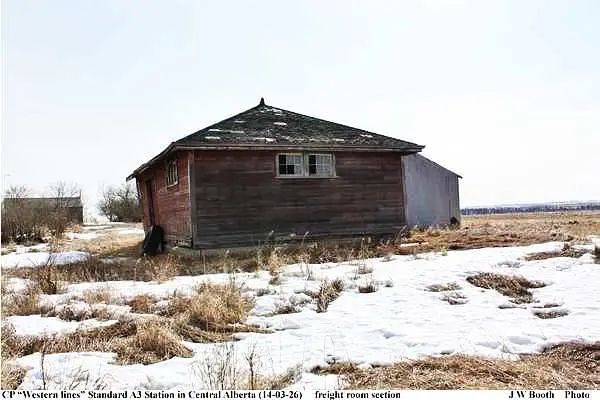 |
CPR Western Lines "Standard A3 Station" in Central Alberta
Frieght room Section. March 26, 2014 |
|
| This picture was taken and submitted by Jim Booth, Willingdon AB | ||
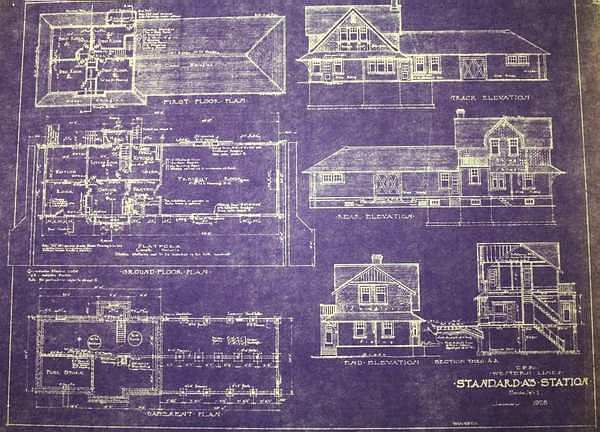
Click on this image for a larger view in a new window |
Blue print for the CP "Western lines" Standard A3 Station.
The station in the pictures is a reversal of the attached plan. Also the station has sat in it�s present location for over 20 years, and sits at the top of a small hill. |
|
| This picture was taken and submitted by Jim Booth, Willingdon AB | ||
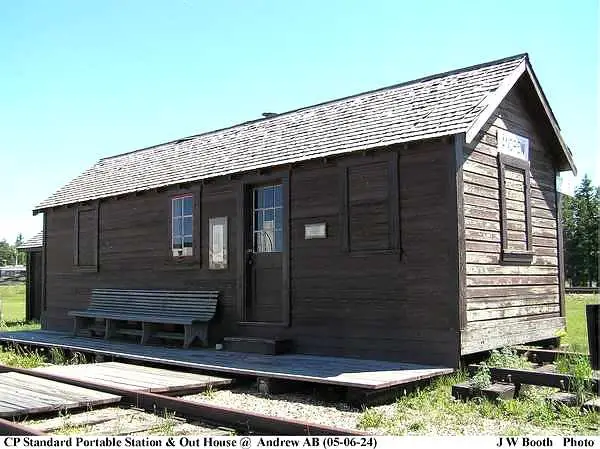 |
CP Portable Station, Andrew AB.
The Andrew building was a gift from the CP railway, it was never used at that location. |
|
| This picture was taken and submitted by Jim Booth, Willingdon AB | ||
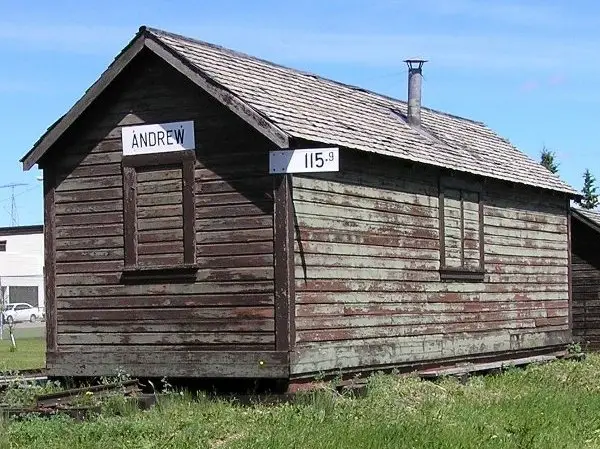 |
CP Portable Station, Andrew AB.
The Andrew building was a gift from the CP railway, it was never used at that location. |
|
| This picture was taken and submitted by Jim Booth, Willingdon AB | ||
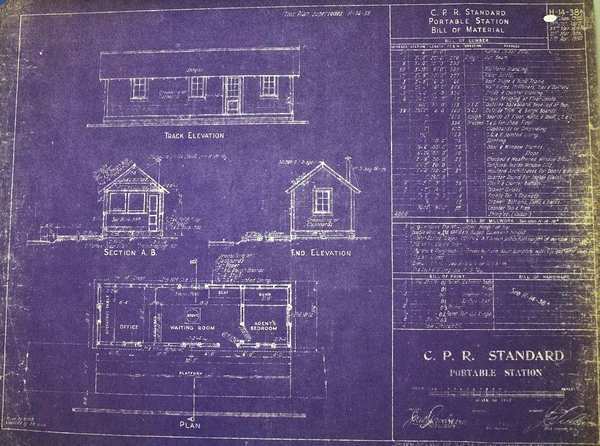
Click on this image for a larger view in a new window |
Blue print for a CP Standard Portable Station | |
| This picture was taken and submitted by Jim Booth, Willingdon AB | ||
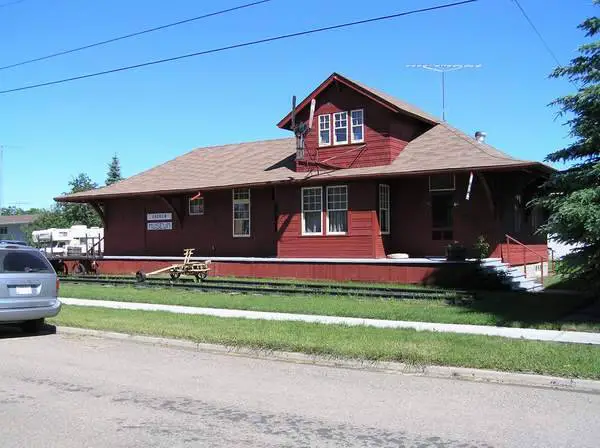 |
CP Station, Andrew, AB
This station is now used as a senior center and museum |
|
| This picture was taken and submitted James Booth, Willingdon AB | ||
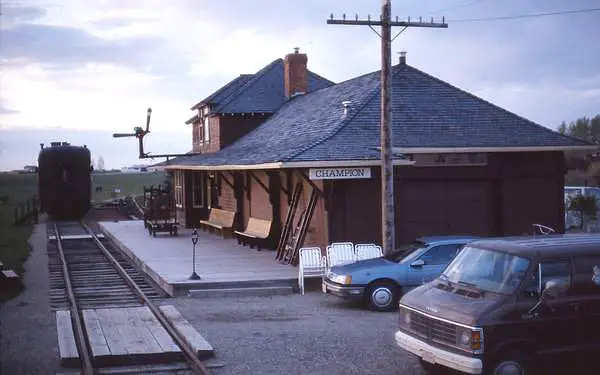 |
Champion CPR Station, rescued from the wreckers and
transported to a private property, along with some railway artifacts, including CPR #19 (see my diesel page) The station now located south of Calgary, 3 km north of
The Village of Champion is located between Lethbridge
|
|
| This picture was taken and submitted by Massey F. Jones | ||
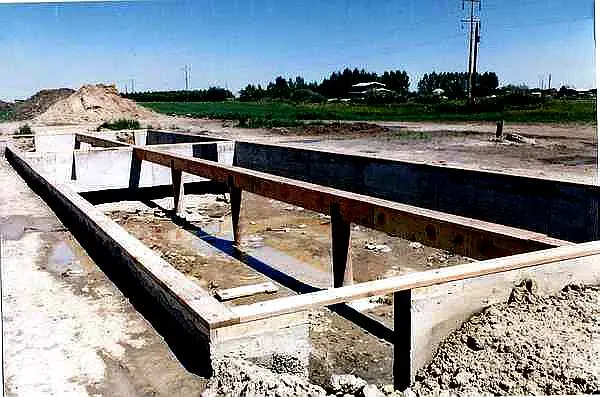 |
The following series of pictures shows the Champion AB
station being moved as described in the picture above which was submitted by Massey F. Jones To see what Champion Park is all about you might want to
The foundation was laid first |
|
| This picture was taken and submitted by Chris Bruckshaw | ||
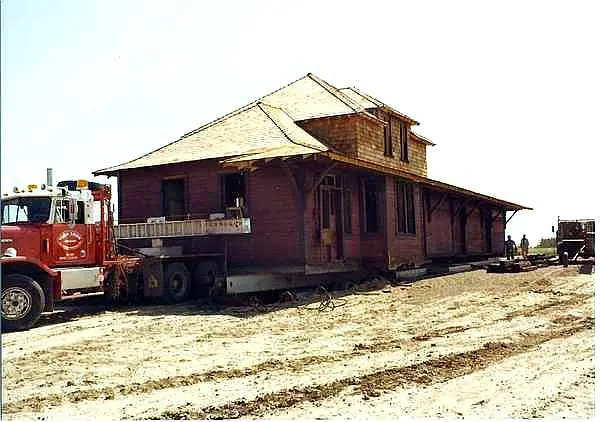 |
The Champion Station was located in Champion Alberta and
moved to it's present location about 4 miles south of the Okotoks turnoff on Hwy 2. Gerald Knowlton the owner purchased the station back in 1982-83 and had it restored. His Father was the station master of this station in Champion. Other buildings were built on site as well as an engine and a few railway cars. In other words Mr. Knowlton has a real scale switching layout. The property has a lake stocked with trout and is mainly used for private functions. The move was done by York Shaw Building Movers and Chris
The station was hauled into place |
|
| This picture was taken and submitted by Chris Bruckshaw | ||
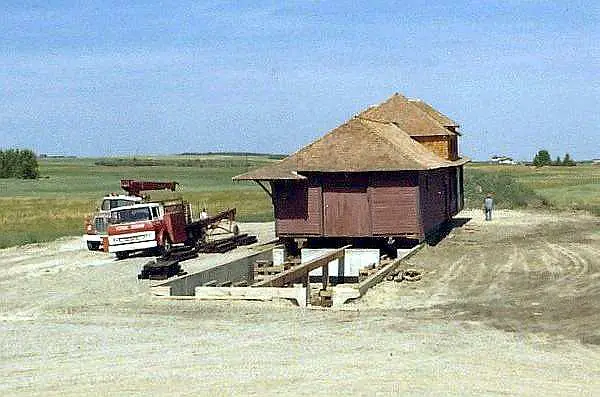 |
and then slid on the foundation. | |
| This picture was taken and submitted by Chris Bruckshaw | ||
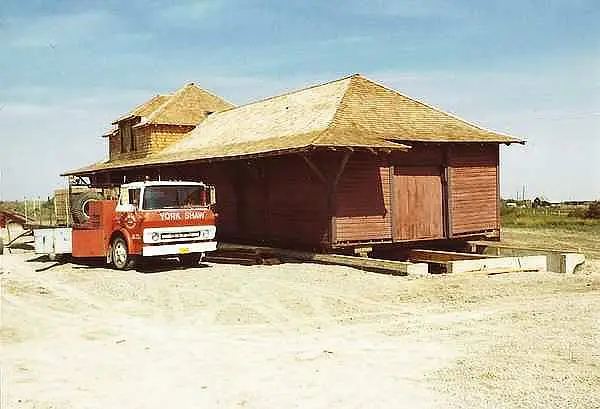 |
It was then carefully put in place | |
| This picture was taken and submitted by Chris Bruckshaw | ||
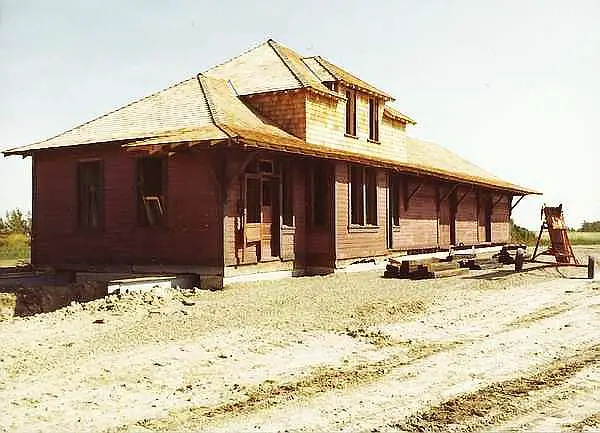 |
Next came the detail work | |
| This picture was taken and submitted by Chris Bruckshaw | ||
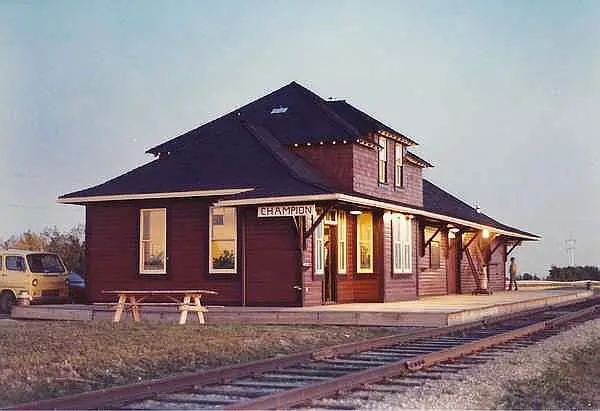 |
and the finished product. | |
| This picture was taken and submitted by Chris Bruckshaw | ||
.jpg) |
A CN Railiner blasts past DUAGH station, about 10
miles straight north of Edmonton on the Coronado Sub on Friday September 12, 1958. This is a scan from a print which has become damaged with age. The RDC served St.Paul, Grand Centre and
|
|
| Massey F. Jones collection | ||
 |
CN DUAGH is second from the bottom on this
employee timetable from April 1978. It doesn't show any passenger service as VIA had earlier decided to terminate a public service that had been ongoing for many years. During its operation, passengers left North Edmonton
|
|
| Massey F. Jones collection | ||
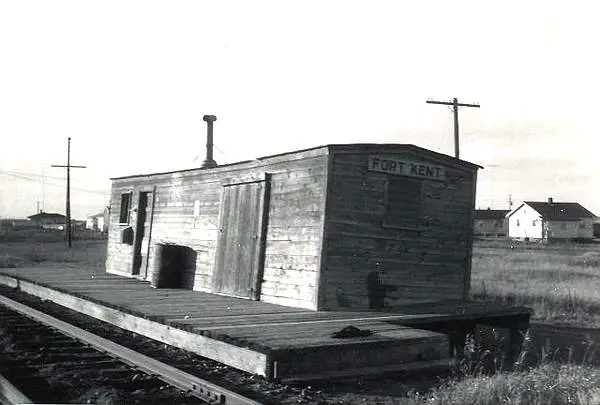 |
The CN Stop at FORT KENT, a hamlet in Central Alberta
within the Municipal District of Bonnyville, Alberta. It is an example of prefabricated portable structures dropped off along the way in many hamlets, in the early days. Serving as a flag stop, the building also held supplies for railway servicing. Fort Kent is approximately 32 km (20 miles) southwest
|
|
| Massey F. Jones collection |
| This picture was taken and submitted James Booth, Willingdon AB | |
|
|
CP Station, Willington, AB
This station is located at the Shandro museum just north of town. It is intact but unheated and has no electricty. |
| This picture was taken and submitted James Booth, Willingdon AB | |
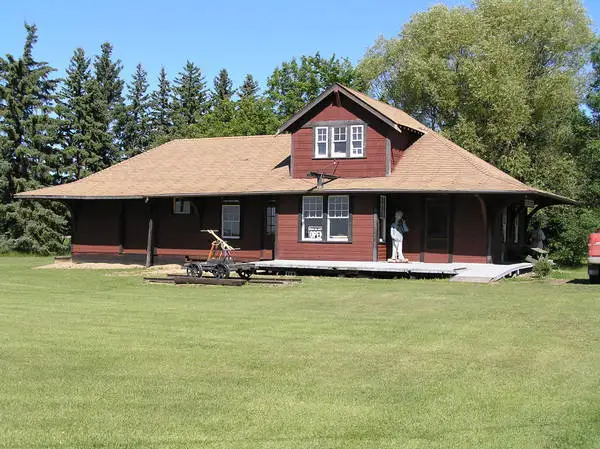 |
CP Station, Willington, AB |
| This picture was taken and submitted James Booth, Willingdon AB | |
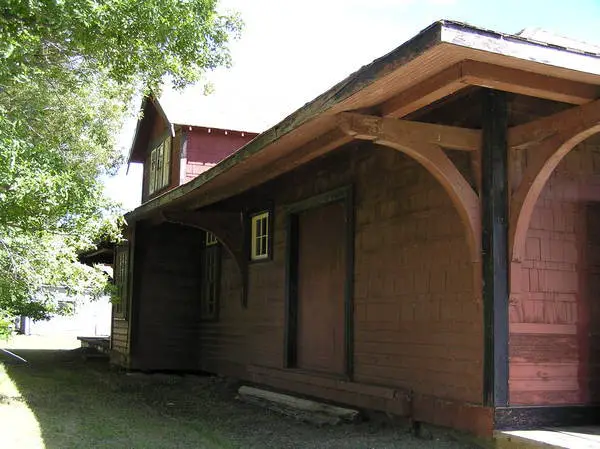 |
CP Station, Willington, AB |
| This picture was taken and submitted James Booth, Willingdon AB | |
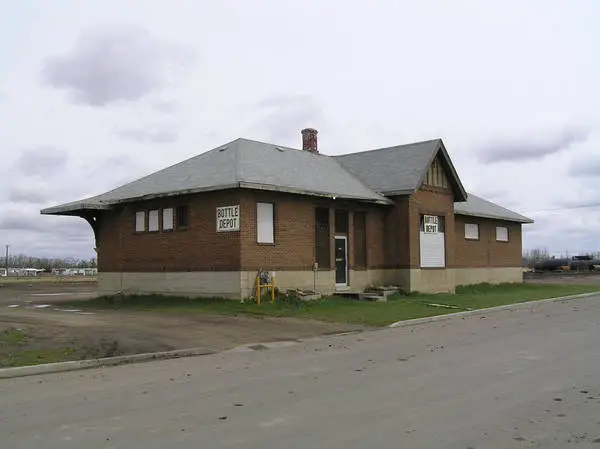 |
CP Station Vegreville, AB
This station is used as a bottle depot. |
| This picture was taken and submitted James Booth, Willingdon AB | |
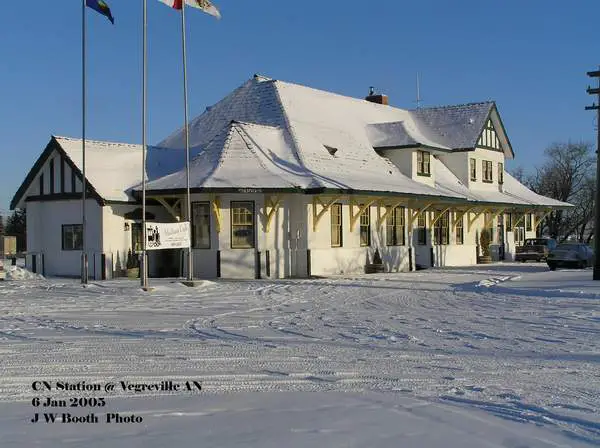 |
CN Station, Vegerville, AB taken on Jan 6, 2005
It looks cold that day and Jim says that it was about minus 30 degrees C . |
| This picture was taken and submitted James Booth, Willingdon AB | |
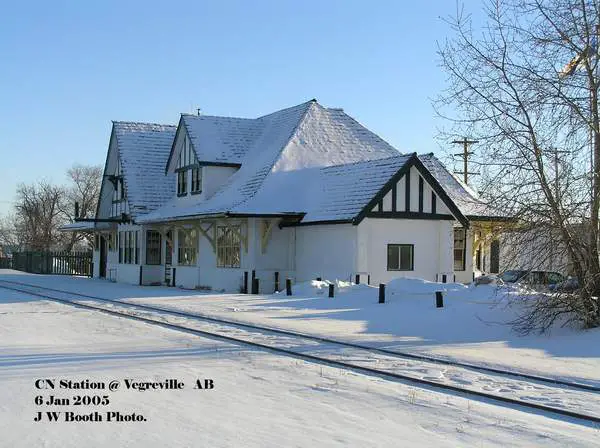 |
CN Station, Vegerville, AB taken on Jan 6, 2005 |
| This picture was taken and submitted James Booth, Willingdon AB | |
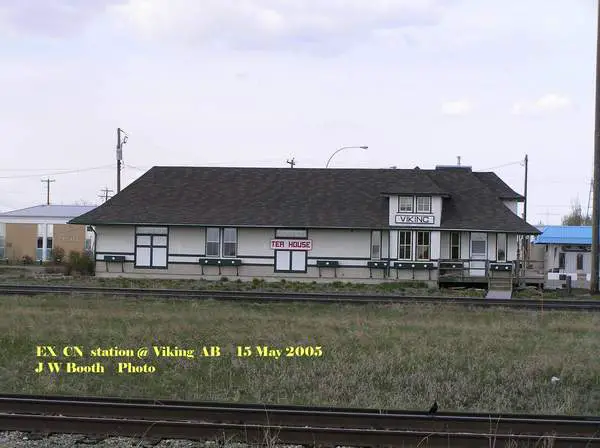 |
CN Station Viking Alberta, May 2005
This station is on the line between Edmonton & Wainwright AB |
| This picture was taken and submitted by Jim Booth, Willingdon AB | |
|
|
Formerly the CNR and VIA station in downtown Edmonton
(until the rails were removed to make way for construction of the Grant McEwan University Downttown Campus and VIA Rail moved its passenger station further north), this building at 10004 104 Ave NW served as CN headquarters in Western Canada for many of its operations on 13 of its 26 floors, and one of Edmonton's tallest buildings at 111 metres (364 ft) in its time. My Diesel page shows a black & white photo of the Super Continental behind the building in the 70s. Built in 1966,the CN Tower was vacated by CN in May 2008 http://www.cawcouncil4000.com
This view, taken in October 2011 shows that the CN logo
|
| This picture was taken and submitted by Massey F. Jones | |
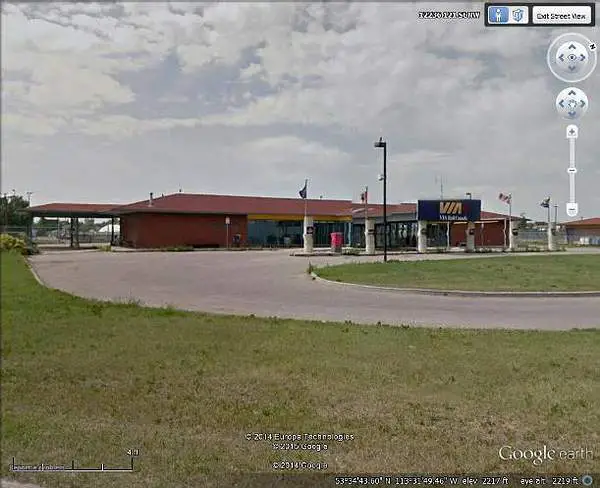 |
The VIA Rail station, at 12360-121 Street NW in Edmonton,
Alberta is situated next to the former Edmonton City Centre (Blatchford Field) airport � now decommissioned and a couple of blocks south of the CN Walker yard. It was opened in 1998 following the closure of the downtown
|
| Google Earth Street View - Submitted by Massey F. Jones | |
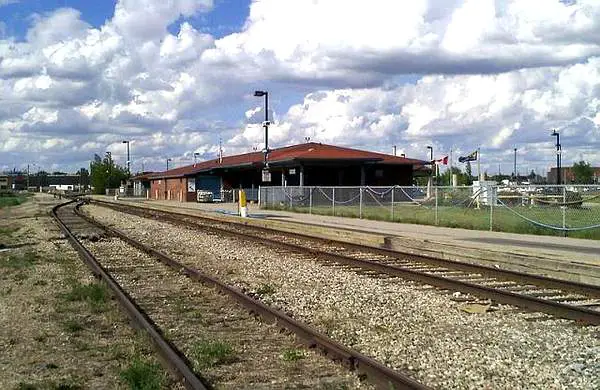 |
The VIA Rail Edmonton Station trackside |
| This picture was taken and submitted by Massey F. Jones | |
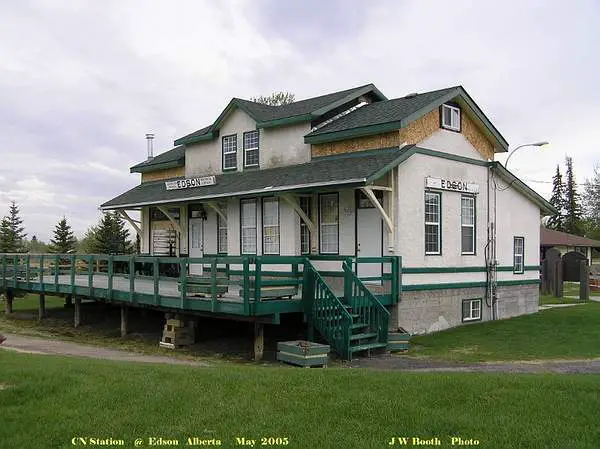 |
EX CN Station Edson AB May 2005 |
| This picture taken and submitted James Booth, Willingdon AB | |
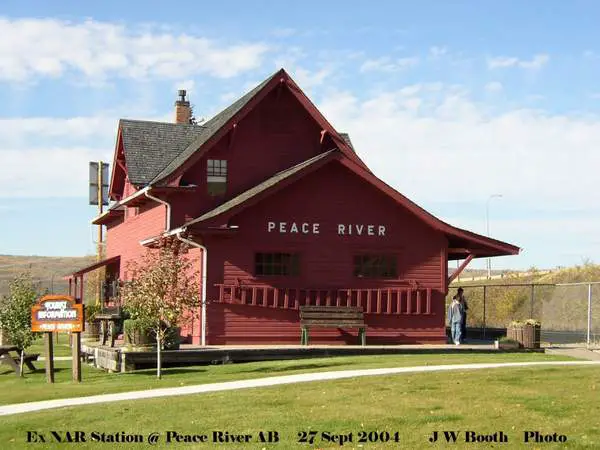 |
EX NAR Station Peace River Alta, Sept 2004 |
| This picture taken and submitted James Booth, Willingdon AB | |
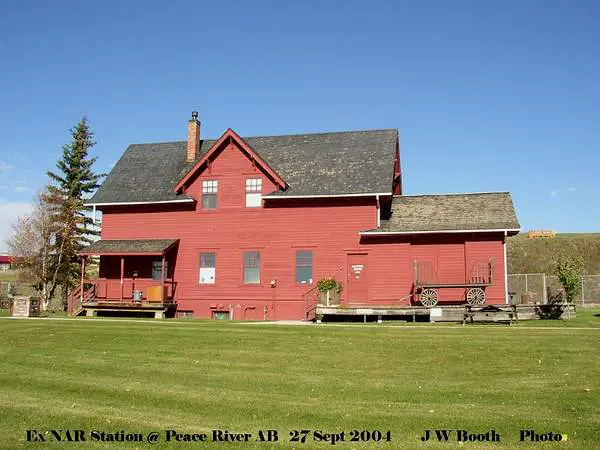 |
EX NAR Station Peace River Alta, Sept 2004 |
| This picture taken and submitted James Booth, Willingdon AB | |
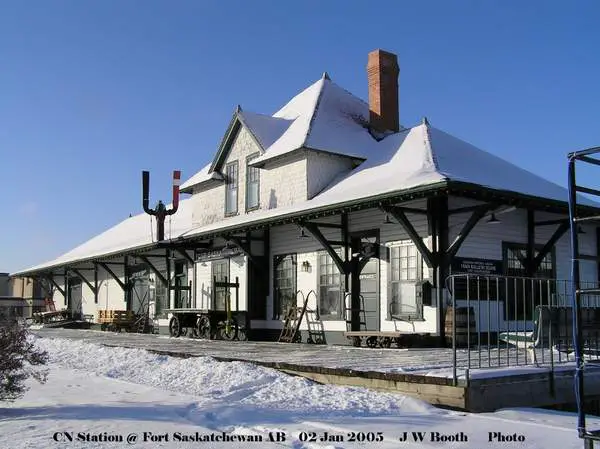 |
CN Fort Saskatchewan AB Station Jan 2005 |
| This picture taken and submitted James Booth, Willingdon AB |
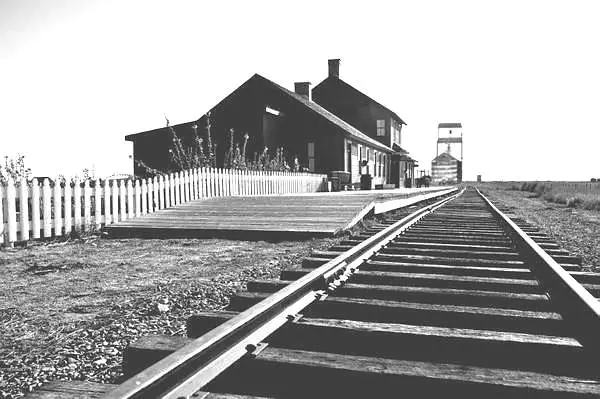 |
Alberta Railway and Coal Co Station 1890,
ex CPR Coutts located at Galt Historic Railway Park, County of Warner Alberta. This photo taken in about 1910 of the international border, includes
the employees of the Coutts Sweetgrass International Customs Depot, Train
Station.
Bill found the following information on this station.
|
| This picture was submitted by Bill Hillen, Lethbridge Alberta | |
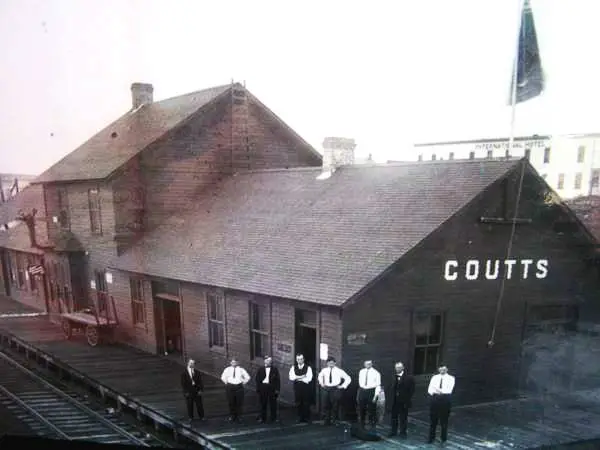 |
Coutts Sweetgrass International Port of Entry,
Coutts Alberta 1910 |
| This picture was submitted by Bill Hillen, Lethbridge Alberta | |
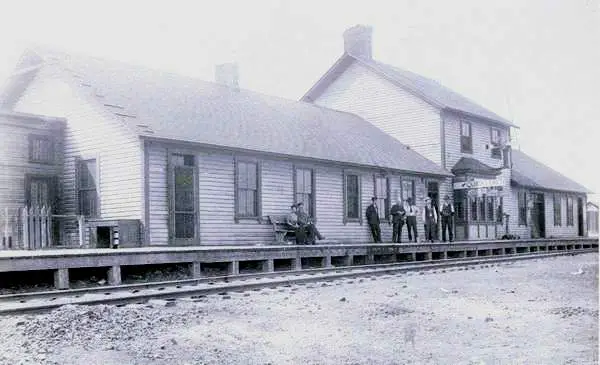 |
CCPR and Great Northern. Port of Entry,
Coutts Alberta 1910 |
| This picture was submitted by Bill Hillen, Lethbridge Alberta | |
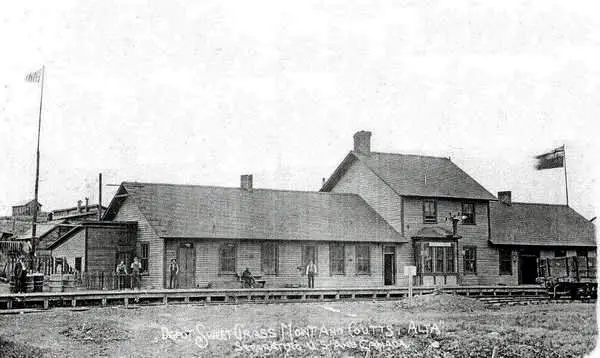 |
CPR and Great Northern. Port of Entry,
Coutts Alberta 1910 |
| This picture was submitted by Bill Hillen, Lethbridge Alberta | |
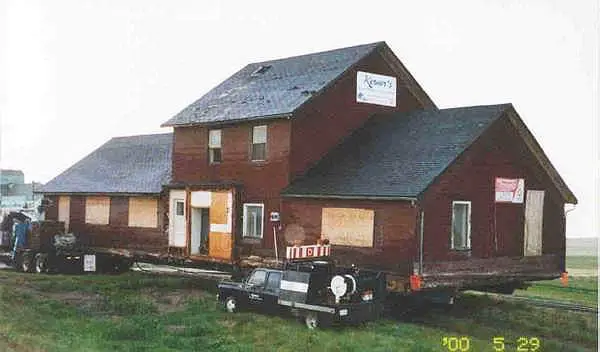 |
Moving the former Coutts CPR station out of Coutts
May 2000 |
| This picture was submitted by Bill Hillen, Lethbridge Alberta | |
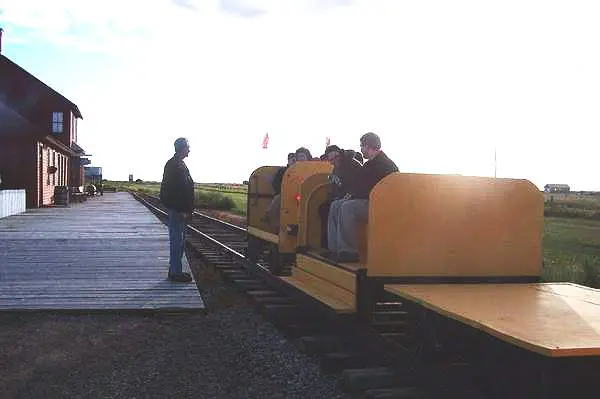 |
Former CPR Coutts station now restored to it's original configuration of 1890 then owned by the Alberta Railway and Coal Co. |
| This picture was submitted by Bill Hillen, Lethbridge Alberta | |
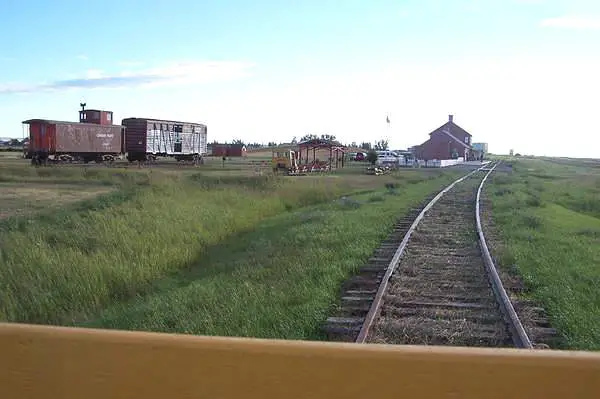 |
Alberta Railway and Coal Co. station open summers
at GHRP |
| This picture was submitted by Bill Hillen, Lethbridge Alberta | |
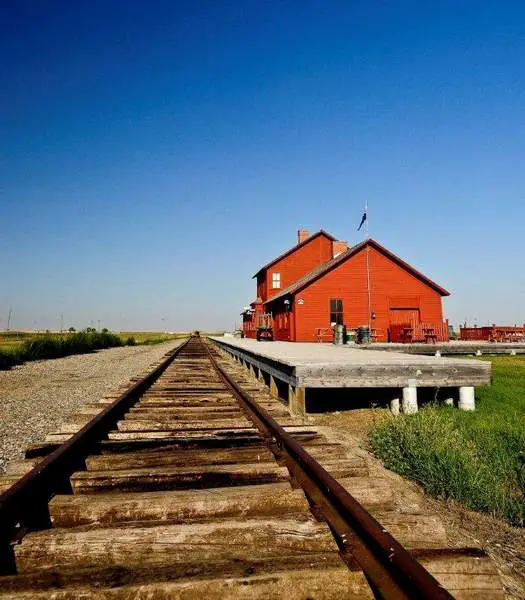 |
ARCC station 9,000 sq ft. Platform looking
east at GHRP 2010 |
| This picture was submitted by Bill Hillen, Lethbridge Alberta |
Links to the other areas of Canada
 |
 |
 |
|
|
|
|
Return
to Old Canadian Train Stations

Two site worth looking at.
The
Memory Lane Railway Museum in Middleton, Nova Scotia.
The
only exclusive Dominion Atlantic Railway museum in the world
Welcome
to the DAR DPI
A web
community initiative intent on digitally preserving
the history
of the Dominion Atlantic Railway
| Privacy Policy for http://yourrailwaypictures.com/
If you require any more information or have any questions about our privacy policy, please feel free to contact us by us by email at john@summervillens.ca At http://yourrailwaypictures.com/, the privacy of our visitors is of extreme importance to us. This privacy policy document outlines the types of personal information is received and collected by http://yourrailwaypictures.com/ and how it is used. Log Files
Cookies and Web Beacons
DoubleClick DART Cookie
Some of our advertising partners may use cookies and web beacons on
our site. Our advertising partners include ....
These third-party ad servers or ad networks use technology to the advertisements and links that appear on http://yourrailwaypictures.com/ send directly to your browsers. They automatically receive your IP address when this occurs. Other technologies ( such as cookies, JavaScript, or Web Beacons ) may also be used by the third-party ad networks to measure the effectiveness of their advertisements and / or to personalize the advertising content that you see. http://yourrailwaypictures.com/ has no access to or control over these cookies that are used by third-party advertisers. You should consult the respective privacy policies of these third-party ad servers for more detailed information on their practices as well as for instructions about how to opt-out of certain practices. http://yourrailwaypictures.com/'s privacy policy does not apply to, and we cannot control the activities of, such other advertisers or web sites. If you wish to disable cookies, you may do so through your individual browser options. More detailed information about cookie management with specific web browsers can be found at the browsers' respective websites. |